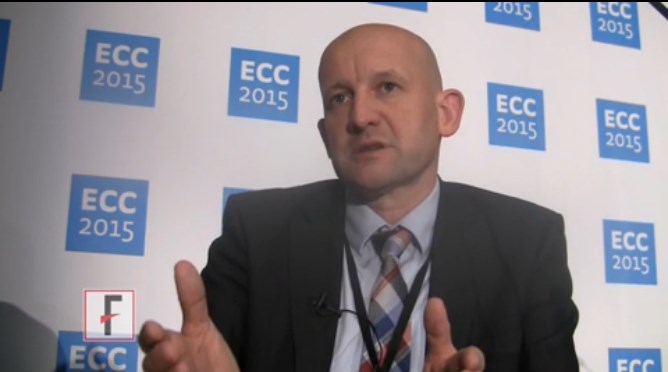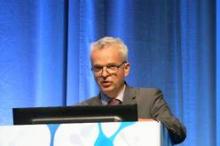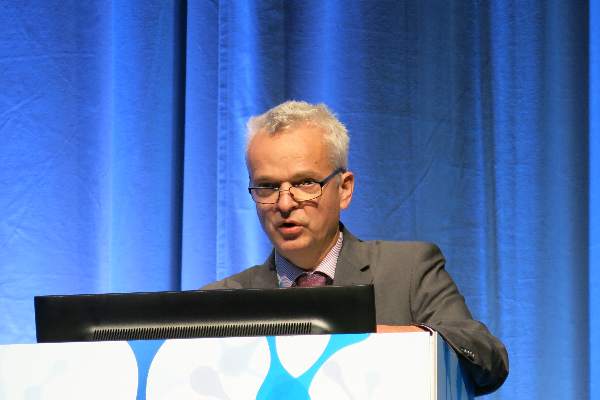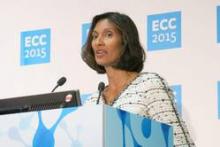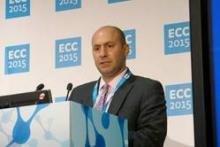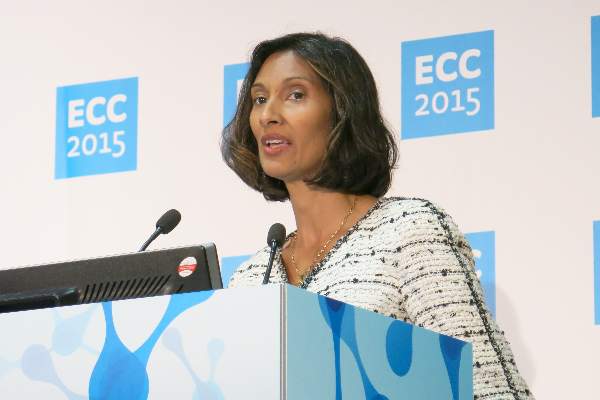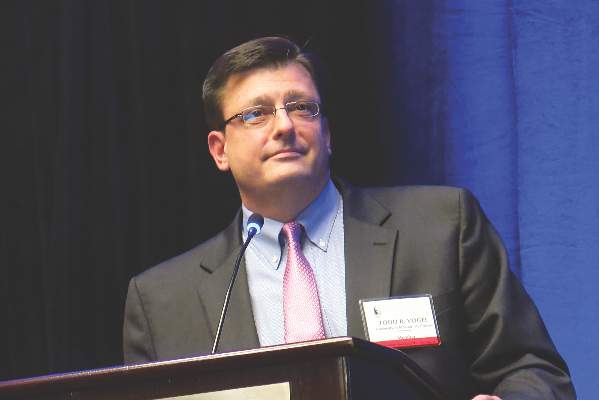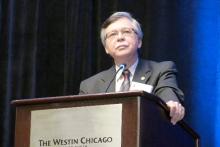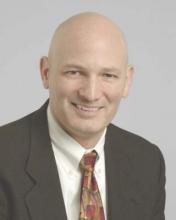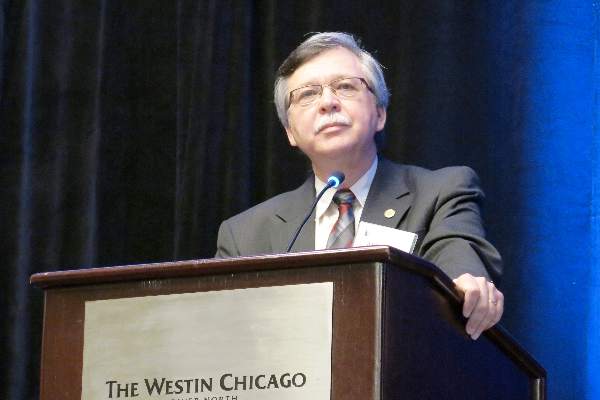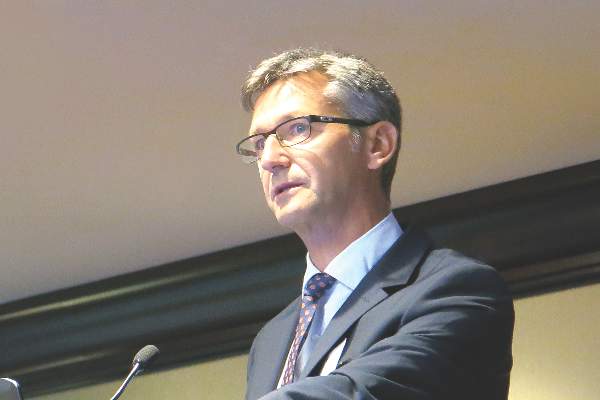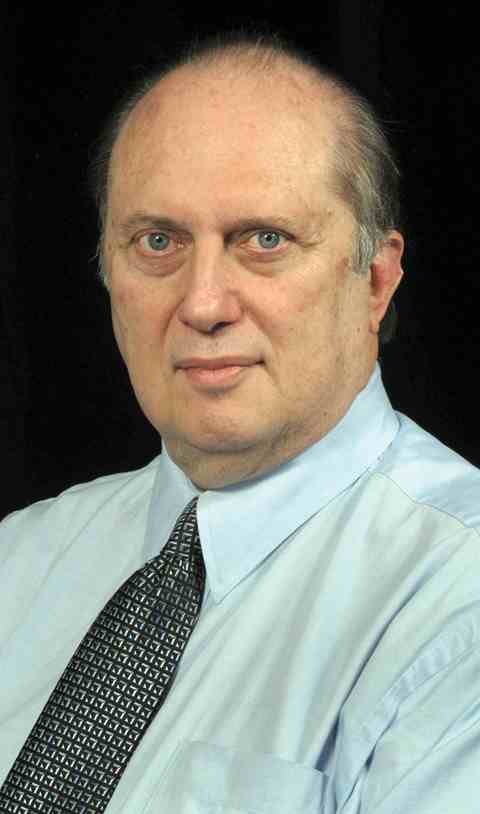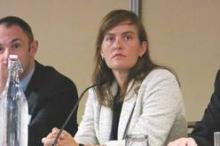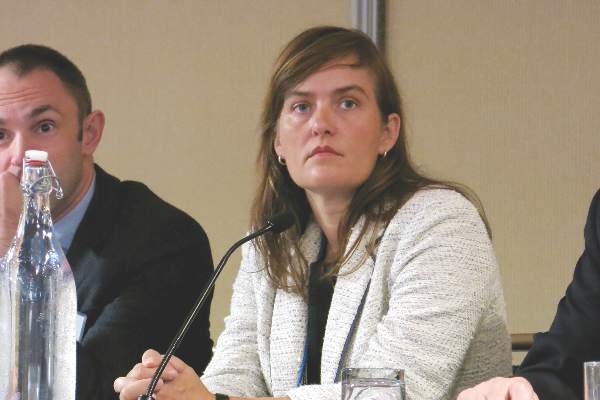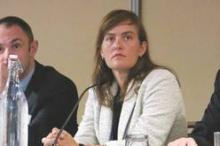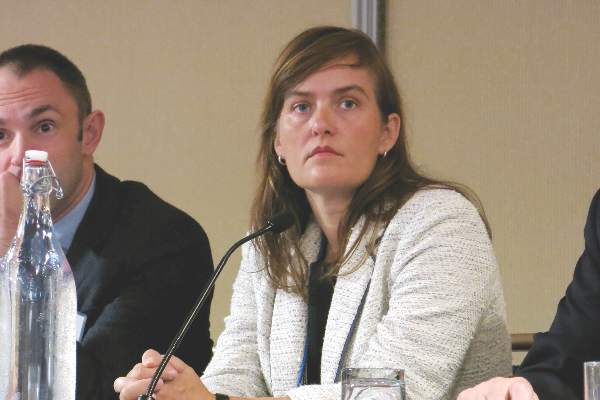User login
VIDEO: Pediatric outcomes reassuring after cancer treatment during pregnancy
VIENNA – Children whose mothers had cancer while pregnant had similar cognitive, cardiac, and general development in early childhood as did those born to women without cancer, according to results presented at the European Cancer Congress and simultaneously published in the New England Journal of Medicine.
The case-control study found no significant differences in mental development among children exposed to chemotherapy, radiotherapy, surgery alone, or no treatment. In addition, the number of chemotherapy cycles during pregnancy, which ranged from 1 to 10, also had no impact on mental development when measured at 18 months and 3 years, Dr. Frédéric Amant, a gynecologic oncologist at University Hospitals Leuven, Belgium and at Antoni van Leeuwenhoek in Amsterdam, said during a press briefing.
Chemotherapy was given in only the second and third trimesters, he noted.
During pregnancy, 96 of the 129 children were exposed to chemotherapy alone or in combination with other treatments, 11 to radiotherapy alone or in combination with other treatments, 13 to surgery alone, 2 to other drugs therapies, and 14 to no treatment. The 129 controls were born to healthy mothers after uncomplicated pregnancies and deliveries (N Engl J Med. Sep 28, doi:10.1056/NEJMoa1508913.).
More than 60% of children with perinatal cancer exposure were born premature, but their development at a median age of 22 months was normal for their gestational age at birth.
The incidence of prematurity is high, but in most cases the children were born prematurely because of a medical decision to induce preterm so the mother could continue cancer therapy after delivery, Dr. Amant said in an interview.
Children with a birthweight below the 10th percentile were born more often to mothers with cancer during pregnancy than were children in the control group, but the difference was not significantly different (22% vs. 15.2%; P = .16).
“Overall, these data should be reassuring to women who are facing a new diagnosis of cancer during pregnancy and to their families,” Dr. Michael Greene, chief of obstetrics at Massachusetts General Hospital in Boston, and Dr. Dan Longo, an oncologist from the Dana Farber Cancer Institute, also in Boston, wrote in an accompanying editorial (N Engl J Med. Sep 28, doi:10.1056/NEJMe1512188.).
“Prudence continues to suggest avoiding cancer treatment in the first trimester, however, treatment in the second and third trimester is likely to be best for both mothers and their offspring,” they stated.
Dr. Peter Naredi, European CanCer Organization scientific cochair of the Congress, said that “while further follow-up of these children is required, the important message at this stage seems to be that doctors should not only start cancer treatment immediately, but should also try to maintain the pregnancy to as near full term as possible.”
The study was funded by the Belgian National Cancer Plan, Research Fund Flanders, Stichting tegen Kanker, Katholieke University Leuven, and Universitaire Ziekenhuizen Leuven. Dr. Amant reported having no financial disclosures. Dr. Greene and Dr. Longo reported that they are editors for the New England Journal of Medicine.
The video associated with this article is no longer available on this site. Please view all of our videos on the MDedge YouTube channel
On Twitter @pwendl
VIENNA – Children whose mothers had cancer while pregnant had similar cognitive, cardiac, and general development in early childhood as did those born to women without cancer, according to results presented at the European Cancer Congress and simultaneously published in the New England Journal of Medicine.
The case-control study found no significant differences in mental development among children exposed to chemotherapy, radiotherapy, surgery alone, or no treatment. In addition, the number of chemotherapy cycles during pregnancy, which ranged from 1 to 10, also had no impact on mental development when measured at 18 months and 3 years, Dr. Frédéric Amant, a gynecologic oncologist at University Hospitals Leuven, Belgium and at Antoni van Leeuwenhoek in Amsterdam, said during a press briefing.
Chemotherapy was given in only the second and third trimesters, he noted.
During pregnancy, 96 of the 129 children were exposed to chemotherapy alone or in combination with other treatments, 11 to radiotherapy alone or in combination with other treatments, 13 to surgery alone, 2 to other drugs therapies, and 14 to no treatment. The 129 controls were born to healthy mothers after uncomplicated pregnancies and deliveries (N Engl J Med. Sep 28, doi:10.1056/NEJMoa1508913.).
More than 60% of children with perinatal cancer exposure were born premature, but their development at a median age of 22 months was normal for their gestational age at birth.
The incidence of prematurity is high, but in most cases the children were born prematurely because of a medical decision to induce preterm so the mother could continue cancer therapy after delivery, Dr. Amant said in an interview.
Children with a birthweight below the 10th percentile were born more often to mothers with cancer during pregnancy than were children in the control group, but the difference was not significantly different (22% vs. 15.2%; P = .16).
“Overall, these data should be reassuring to women who are facing a new diagnosis of cancer during pregnancy and to their families,” Dr. Michael Greene, chief of obstetrics at Massachusetts General Hospital in Boston, and Dr. Dan Longo, an oncologist from the Dana Farber Cancer Institute, also in Boston, wrote in an accompanying editorial (N Engl J Med. Sep 28, doi:10.1056/NEJMe1512188.).
“Prudence continues to suggest avoiding cancer treatment in the first trimester, however, treatment in the second and third trimester is likely to be best for both mothers and their offspring,” they stated.
Dr. Peter Naredi, European CanCer Organization scientific cochair of the Congress, said that “while further follow-up of these children is required, the important message at this stage seems to be that doctors should not only start cancer treatment immediately, but should also try to maintain the pregnancy to as near full term as possible.”
The study was funded by the Belgian National Cancer Plan, Research Fund Flanders, Stichting tegen Kanker, Katholieke University Leuven, and Universitaire Ziekenhuizen Leuven. Dr. Amant reported having no financial disclosures. Dr. Greene and Dr. Longo reported that they are editors for the New England Journal of Medicine.
The video associated with this article is no longer available on this site. Please view all of our videos on the MDedge YouTube channel
On Twitter @pwendl
VIENNA – Children whose mothers had cancer while pregnant had similar cognitive, cardiac, and general development in early childhood as did those born to women without cancer, according to results presented at the European Cancer Congress and simultaneously published in the New England Journal of Medicine.
The case-control study found no significant differences in mental development among children exposed to chemotherapy, radiotherapy, surgery alone, or no treatment. In addition, the number of chemotherapy cycles during pregnancy, which ranged from 1 to 10, also had no impact on mental development when measured at 18 months and 3 years, Dr. Frédéric Amant, a gynecologic oncologist at University Hospitals Leuven, Belgium and at Antoni van Leeuwenhoek in Amsterdam, said during a press briefing.
Chemotherapy was given in only the second and third trimesters, he noted.
During pregnancy, 96 of the 129 children were exposed to chemotherapy alone or in combination with other treatments, 11 to radiotherapy alone or in combination with other treatments, 13 to surgery alone, 2 to other drugs therapies, and 14 to no treatment. The 129 controls were born to healthy mothers after uncomplicated pregnancies and deliveries (N Engl J Med. Sep 28, doi:10.1056/NEJMoa1508913.).
More than 60% of children with perinatal cancer exposure were born premature, but their development at a median age of 22 months was normal for their gestational age at birth.
The incidence of prematurity is high, but in most cases the children were born prematurely because of a medical decision to induce preterm so the mother could continue cancer therapy after delivery, Dr. Amant said in an interview.
Children with a birthweight below the 10th percentile were born more often to mothers with cancer during pregnancy than were children in the control group, but the difference was not significantly different (22% vs. 15.2%; P = .16).
“Overall, these data should be reassuring to women who are facing a new diagnosis of cancer during pregnancy and to their families,” Dr. Michael Greene, chief of obstetrics at Massachusetts General Hospital in Boston, and Dr. Dan Longo, an oncologist from the Dana Farber Cancer Institute, also in Boston, wrote in an accompanying editorial (N Engl J Med. Sep 28, doi:10.1056/NEJMe1512188.).
“Prudence continues to suggest avoiding cancer treatment in the first trimester, however, treatment in the second and third trimester is likely to be best for both mothers and their offspring,” they stated.
Dr. Peter Naredi, European CanCer Organization scientific cochair of the Congress, said that “while further follow-up of these children is required, the important message at this stage seems to be that doctors should not only start cancer treatment immediately, but should also try to maintain the pregnancy to as near full term as possible.”
The study was funded by the Belgian National Cancer Plan, Research Fund Flanders, Stichting tegen Kanker, Katholieke University Leuven, and Universitaire Ziekenhuizen Leuven. Dr. Amant reported having no financial disclosures. Dr. Greene and Dr. Longo reported that they are editors for the New England Journal of Medicine.
The video associated with this article is no longer available on this site. Please view all of our videos on the MDedge YouTube channel
On Twitter @pwendl
AT THE EUROPEAN CANCER CONGRESS 2015
ECC: Pembrolizumab hits mark in heavily pretreated nasopharngeal cancer
VIENNA – Programmed cell death 1 blockade with pembrolizumab proved a good match for nasopharngeal carcinoma, a notoriously difficult-to-treat cancer, in the phase Ib KEYSTONE-028 study.
The objective response rate among 27 heavily pretreated patients with metastatic or recurrent nasopharngeal cancer was 22.2%, including 6 partial responses.
Six patients progressed and 15 had stable disease, bringing the disease control rate to 77.8%, Dr. Chiun Hsu, of National Taiwan University Hospital in Taipei, reported at the European Cancer Congress.
Almost two-thirds of patients (67%) experienced a decrease in target lesions with pembrolizumab (Keytruda). Tumor shrinkage seen in responders at the first assessment.
The median time to response was quite short at 1.8 months, but the responses were quite durable, lasting a median of 10.8 months, he said.
Invited discussant Dr. Ulrich Keilholz, director of the Charité Comprehensive Cancer Center in Berlin, commented, “In those patients with regression, we see quite long-lasting responses. This is very rewarding and interesting.”
There were no late responses after the initial progression or evidence of pseudoprogression, which has been seen with other immunotherapies.
“So the question is really whether we need to keep patients on study if they have progression since we did not see something we saw with ipilimumab (Yervoy) in other diseases, where we had an initial progression and then late response,” he said.
Median progression-free survival was 5.6 months, but ranged from 3.6 months to 11 months, Dr. Hsu said. The PFS rate at 6 months was 49.7% and at 12 months 29%.
“This study is the first demonstration of robust clinical activity of a PD-1 inhibitor in patients with recurrent and metastatic nasopharyngeal carcinoma,” he said.
Recent studies have shown that about a third of patients with nasopharngeal carcinoma will recur after primary treatment and that progression-free survival is typically less than 6 months in recurrent and metastatic disease after failure of platinum-based chemotherapy, Dr. Keilholz observed.
Pembrolizumab has shown clinical activity in more than a dozen tumor types and works by binding to the programmed cell death 1 (PD-1) receptor and blocking its interaction with PD-1 ligand 1 (PD-L1) and 2 (PD-L2). Nasopharyngeal cancer almost universally expresses PD-L1, Dr. Keilholz said.
The 27 patients were drawn from the ongoing, multicohort KEYSTONE-028 study of pembrolizumab in PD-L1-positive advanced solid tumors and received pembrolizumab 10 mg/kg intravenously every two weeks for a maximum of 24 weeks or until disease progression or intolerable toxicity. Their median age was 52 years, 78% were male, 63% Asian, 66.6% had WHO class 2/3 tumors, and 29.6% had received 3 prior lines of therapy for advanced disease.
The safety profile was manageable, Dr. Hsu said. The most common treatment-related adverse event of any grade were pruritus (26%), fatigue (18.5%), and hypothyroidism (18.5%). The most notable grade 3-5 adverse events were two cases each of hepatitis and pneumonitis. There was one treatment-related death due to sepsis and four patients discontinued treatment due to adverse events.
Further investigation of pembrolizumab in this setting is planned, Dr. Hsu said.
On Twitter @pwendl
VIENNA – Programmed cell death 1 blockade with pembrolizumab proved a good match for nasopharngeal carcinoma, a notoriously difficult-to-treat cancer, in the phase Ib KEYSTONE-028 study.
The objective response rate among 27 heavily pretreated patients with metastatic or recurrent nasopharngeal cancer was 22.2%, including 6 partial responses.
Six patients progressed and 15 had stable disease, bringing the disease control rate to 77.8%, Dr. Chiun Hsu, of National Taiwan University Hospital in Taipei, reported at the European Cancer Congress.
Almost two-thirds of patients (67%) experienced a decrease in target lesions with pembrolizumab (Keytruda). Tumor shrinkage seen in responders at the first assessment.
The median time to response was quite short at 1.8 months, but the responses were quite durable, lasting a median of 10.8 months, he said.
Invited discussant Dr. Ulrich Keilholz, director of the Charité Comprehensive Cancer Center in Berlin, commented, “In those patients with regression, we see quite long-lasting responses. This is very rewarding and interesting.”
There were no late responses after the initial progression or evidence of pseudoprogression, which has been seen with other immunotherapies.
“So the question is really whether we need to keep patients on study if they have progression since we did not see something we saw with ipilimumab (Yervoy) in other diseases, where we had an initial progression and then late response,” he said.
Median progression-free survival was 5.6 months, but ranged from 3.6 months to 11 months, Dr. Hsu said. The PFS rate at 6 months was 49.7% and at 12 months 29%.
“This study is the first demonstration of robust clinical activity of a PD-1 inhibitor in patients with recurrent and metastatic nasopharyngeal carcinoma,” he said.
Recent studies have shown that about a third of patients with nasopharngeal carcinoma will recur after primary treatment and that progression-free survival is typically less than 6 months in recurrent and metastatic disease after failure of platinum-based chemotherapy, Dr. Keilholz observed.
Pembrolizumab has shown clinical activity in more than a dozen tumor types and works by binding to the programmed cell death 1 (PD-1) receptor and blocking its interaction with PD-1 ligand 1 (PD-L1) and 2 (PD-L2). Nasopharyngeal cancer almost universally expresses PD-L1, Dr. Keilholz said.
The 27 patients were drawn from the ongoing, multicohort KEYSTONE-028 study of pembrolizumab in PD-L1-positive advanced solid tumors and received pembrolizumab 10 mg/kg intravenously every two weeks for a maximum of 24 weeks or until disease progression or intolerable toxicity. Their median age was 52 years, 78% were male, 63% Asian, 66.6% had WHO class 2/3 tumors, and 29.6% had received 3 prior lines of therapy for advanced disease.
The safety profile was manageable, Dr. Hsu said. The most common treatment-related adverse event of any grade were pruritus (26%), fatigue (18.5%), and hypothyroidism (18.5%). The most notable grade 3-5 adverse events were two cases each of hepatitis and pneumonitis. There was one treatment-related death due to sepsis and four patients discontinued treatment due to adverse events.
Further investigation of pembrolizumab in this setting is planned, Dr. Hsu said.
On Twitter @pwendl
VIENNA – Programmed cell death 1 blockade with pembrolizumab proved a good match for nasopharngeal carcinoma, a notoriously difficult-to-treat cancer, in the phase Ib KEYSTONE-028 study.
The objective response rate among 27 heavily pretreated patients with metastatic or recurrent nasopharngeal cancer was 22.2%, including 6 partial responses.
Six patients progressed and 15 had stable disease, bringing the disease control rate to 77.8%, Dr. Chiun Hsu, of National Taiwan University Hospital in Taipei, reported at the European Cancer Congress.
Almost two-thirds of patients (67%) experienced a decrease in target lesions with pembrolizumab (Keytruda). Tumor shrinkage seen in responders at the first assessment.
The median time to response was quite short at 1.8 months, but the responses were quite durable, lasting a median of 10.8 months, he said.
Invited discussant Dr. Ulrich Keilholz, director of the Charité Comprehensive Cancer Center in Berlin, commented, “In those patients with regression, we see quite long-lasting responses. This is very rewarding and interesting.”
There were no late responses after the initial progression or evidence of pseudoprogression, which has been seen with other immunotherapies.
“So the question is really whether we need to keep patients on study if they have progression since we did not see something we saw with ipilimumab (Yervoy) in other diseases, where we had an initial progression and then late response,” he said.
Median progression-free survival was 5.6 months, but ranged from 3.6 months to 11 months, Dr. Hsu said. The PFS rate at 6 months was 49.7% and at 12 months 29%.
“This study is the first demonstration of robust clinical activity of a PD-1 inhibitor in patients with recurrent and metastatic nasopharyngeal carcinoma,” he said.
Recent studies have shown that about a third of patients with nasopharngeal carcinoma will recur after primary treatment and that progression-free survival is typically less than 6 months in recurrent and metastatic disease after failure of platinum-based chemotherapy, Dr. Keilholz observed.
Pembrolizumab has shown clinical activity in more than a dozen tumor types and works by binding to the programmed cell death 1 (PD-1) receptor and blocking its interaction with PD-1 ligand 1 (PD-L1) and 2 (PD-L2). Nasopharyngeal cancer almost universally expresses PD-L1, Dr. Keilholz said.
The 27 patients were drawn from the ongoing, multicohort KEYSTONE-028 study of pembrolizumab in PD-L1-positive advanced solid tumors and received pembrolizumab 10 mg/kg intravenously every two weeks for a maximum of 24 weeks or until disease progression or intolerable toxicity. Their median age was 52 years, 78% were male, 63% Asian, 66.6% had WHO class 2/3 tumors, and 29.6% had received 3 prior lines of therapy for advanced disease.
The safety profile was manageable, Dr. Hsu said. The most common treatment-related adverse event of any grade were pruritus (26%), fatigue (18.5%), and hypothyroidism (18.5%). The most notable grade 3-5 adverse events were two cases each of hepatitis and pneumonitis. There was one treatment-related death due to sepsis and four patients discontinued treatment due to adverse events.
Further investigation of pembrolizumab in this setting is planned, Dr. Hsu said.
On Twitter @pwendl
AT THE EUROPEAN CANCER CONGRESS 2015
Key clinical point: Pembrolizumab is clinically active and produces durable responses in patients with recurrent or metastatic nasopharyngeal cancer.
Major finding: The objective response rate was 22%.
Data source: Phase 1b study in 27 patients with recurrent or metastatic nasopharyngeal carcinoma.
Disclosures: KEYNOTE-028 is supported by Merck, Sharp & Dohme. Dr. Hsu reported having no conflicts to disclose.
ECC: Nivolumab, Cabozantinib bring long overdue options to advanced kidney cancer
VIENNA – The immune checkpoint inhibitor nivolumab extended overall survival by 5.4 months compared with standard therapy in patients with advanced kidney cancer in the phase III CheckMate 025 trial.
The primary end point of median overall survival was 25 months with nivolumab (Opdivo) and 19.6 months with everolimus (Afinitor), representing a 27% reduction in the risk of all-cause death (Hazard Ratio for death, 0.73; P = .0018).
The survival benefit with the programmed death 1 (PD-1) inhibitor was seen irrespective of tumor PD-1 ligand 1 (PD-L1) expression, sex, or age and was accompanied by more objective responses and fewer serious side effects than everolimus.
“The survival improvement and favorable safety profile demonstrated in this phase III trial provides evidence for nivolumab as a potential new treatment option for previously treated patients with metastatic renal cell carcinoma (RCC),” study author Dr. Padmanee Sharma, of the University of Texas MD Anderson Cancer Center in Houston, said during a press briefing at the European Cancer Congress. The results were also simultaneously published in the New England Journal of Medicine (DOI:10.1056/NEJMoa1510665).
This is the only phase III trial to demonstrate a survival advantage in previously treated patients with metastatic RCC versus standard therapy, she said.
Based on the positive results, the trial was stopped early and nivolumab was recently granted breakthrough therapy designation from the Food and Drug Administration for advanced RCC.
CheckMate 025 randomly assigned 821 patients with advanced clear-cell RCC to 3 mg/kg nivolumab intravenously every 2 weeks or 10 mg everolimus orally once-daily until progression or intolerable toxicity. After the trial was halted, patients taking everolimus were allowed to cross over to nivolumab. Their median age was 62 years, 75% were male, and 72% of patients had received at least one prior antiangiogenic regimen for advanced disease.
Patients on nivolumab had a significantly better objective response rate than with everolimus (25% vs. 5%; odds ratio, 5.98; P <.001), including partial responses in 24% vs. 5% and complete responses in 4 patients vs. 2 patients (1% vs. < 1%).
Median progression-free survival was similar at 4.6 months with nivolumab and 4.4 months with everolimus (HR, 0.88; P= .11).
Dr. Sharma defended the 5.6-month gain in overall survival, cautioning that immune checkpoint therapies have the potential for durable responses that can last years and that the minimum follow-up in the trial was only 14 months.
It is unclear how long patients with RCC could anticipate remaining on nivolumab immunotherapy, although nivolumab is approved in melanoma and lung cancer until disease progression or toxicity and various dosing schedules are being explored, she said.
The median duration of treatment in the trial was 5.5 months (range < .01 to 29.6 months) with nivolumab and 3.7 months (range 0.2 to 25.7 months) with everolimus.
Invited discussant Dr. Cora Sternberg, of San Camillo and Forlanini Hospitals in Rome, said, “The overall survival of 25 months sets a new benchmark for patients with previously treated metastatic renal cell carcinoma.”
The results, however, pertain only to patients treated with antiangiogenic agents and the fate of patients with sarcomatoid elements is also unknown because the trial required only a clear-cell component, she added.
It is unclear why the PD-L1 biomarker was negative for overall survival, Dr. Sternberg said, adding that standardization of PD-L1 testing is urgently needed.
Grade 3/4 treatment-related adverse events in CheckMate 025 occurred in 19% of patients taking nivolumab and 37% taking everolimus, most commonly fatigue in 10 patients with nivolumab and anemia in 31 patients with everolimus. There were no treatment-related deaths in the nivolumab arm and two (one from septic shock and one from bowel ischemia) in the everolimus group, Dr. Sharma said.
The most common adverse events of any grade were fatigue (33%), nausea (14%), and pruritus (14%) for nivolumab and fatigue (34%), stomatitis (29%), and anemia (24%) for everolimus.
METEOR
Positive results from METEOR, another late-breaking phase III trial reported in the presidential session and simultaneously published in the New England Journal of Medicine (DOI:10.1056/NEJMoa1510016), are also likely to reshape treatment for advanced RCC.
Cabozantinib (Cometriq) reduced the risk of progression or death by 42% compared with everolimus in 650 patients with RCC who had progressed after vascular endothelial growth factor receptor (VEGFR) therapy (7.4 months vs. 3.8; HR, 0.58; P < .001). Roughly 10% of patients had received prior nivolumab.
There was also strong trend toward improved overall survival favoring cabozantinib, an oral multitargeted VEGFR, MET, and AXL tyrosine kinase inhibitor. But, the data were immature and the outcome did not achieve the P value of .0019 or less required for the planned interim analysis (HR for death, 0.67; P= .005), study author Dr. Toni Choueiri, of the Dana-Farber Cancer Institute in Boston, told reporters.
“It’s a great day for kidney cancer patients,” he said of the two trials.
Dr. Sternberg commented, “This is a new treatment option for second or later-line therapy.”
Both Dr. Sharma and Dr. Choueiri noted that combination therapy is the next logical step, with studies already underway that combine immuotherapies with standard agents.
As for how best to sequence the two therapies in RCC, Dr. Sharma sided with nivolumab because overall survival is the “gold standard.” Dr. Choueiri said the overall survival with nivolumab was “striking,” but that more time is needed to determine the true overall survival benefit with cabozantinib since only about 49% of events have been reported. Factors such as patient preference, oral vs. intravenous administration, and cost will also play a role in the decision, he said, adding, “It’s an embarrassment of riches for patients.”
Press briefing moderator, Dr. Martine Piccart, president of the European CanCer Organization, said she shared the excitement over the phase III results, but stressed that many countries will be unable to afford the medications.
On Twitter @pwendl
VIENNA – The immune checkpoint inhibitor nivolumab extended overall survival by 5.4 months compared with standard therapy in patients with advanced kidney cancer in the phase III CheckMate 025 trial.
The primary end point of median overall survival was 25 months with nivolumab (Opdivo) and 19.6 months with everolimus (Afinitor), representing a 27% reduction in the risk of all-cause death (Hazard Ratio for death, 0.73; P = .0018).
The survival benefit with the programmed death 1 (PD-1) inhibitor was seen irrespective of tumor PD-1 ligand 1 (PD-L1) expression, sex, or age and was accompanied by more objective responses and fewer serious side effects than everolimus.
“The survival improvement and favorable safety profile demonstrated in this phase III trial provides evidence for nivolumab as a potential new treatment option for previously treated patients with metastatic renal cell carcinoma (RCC),” study author Dr. Padmanee Sharma, of the University of Texas MD Anderson Cancer Center in Houston, said during a press briefing at the European Cancer Congress. The results were also simultaneously published in the New England Journal of Medicine (DOI:10.1056/NEJMoa1510665).
This is the only phase III trial to demonstrate a survival advantage in previously treated patients with metastatic RCC versus standard therapy, she said.
Based on the positive results, the trial was stopped early and nivolumab was recently granted breakthrough therapy designation from the Food and Drug Administration for advanced RCC.
CheckMate 025 randomly assigned 821 patients with advanced clear-cell RCC to 3 mg/kg nivolumab intravenously every 2 weeks or 10 mg everolimus orally once-daily until progression or intolerable toxicity. After the trial was halted, patients taking everolimus were allowed to cross over to nivolumab. Their median age was 62 years, 75% were male, and 72% of patients had received at least one prior antiangiogenic regimen for advanced disease.
Patients on nivolumab had a significantly better objective response rate than with everolimus (25% vs. 5%; odds ratio, 5.98; P <.001), including partial responses in 24% vs. 5% and complete responses in 4 patients vs. 2 patients (1% vs. < 1%).
Median progression-free survival was similar at 4.6 months with nivolumab and 4.4 months with everolimus (HR, 0.88; P= .11).
Dr. Sharma defended the 5.6-month gain in overall survival, cautioning that immune checkpoint therapies have the potential for durable responses that can last years and that the minimum follow-up in the trial was only 14 months.
It is unclear how long patients with RCC could anticipate remaining on nivolumab immunotherapy, although nivolumab is approved in melanoma and lung cancer until disease progression or toxicity and various dosing schedules are being explored, she said.
The median duration of treatment in the trial was 5.5 months (range < .01 to 29.6 months) with nivolumab and 3.7 months (range 0.2 to 25.7 months) with everolimus.
Invited discussant Dr. Cora Sternberg, of San Camillo and Forlanini Hospitals in Rome, said, “The overall survival of 25 months sets a new benchmark for patients with previously treated metastatic renal cell carcinoma.”
The results, however, pertain only to patients treated with antiangiogenic agents and the fate of patients with sarcomatoid elements is also unknown because the trial required only a clear-cell component, she added.
It is unclear why the PD-L1 biomarker was negative for overall survival, Dr. Sternberg said, adding that standardization of PD-L1 testing is urgently needed.
Grade 3/4 treatment-related adverse events in CheckMate 025 occurred in 19% of patients taking nivolumab and 37% taking everolimus, most commonly fatigue in 10 patients with nivolumab and anemia in 31 patients with everolimus. There were no treatment-related deaths in the nivolumab arm and two (one from septic shock and one from bowel ischemia) in the everolimus group, Dr. Sharma said.
The most common adverse events of any grade were fatigue (33%), nausea (14%), and pruritus (14%) for nivolumab and fatigue (34%), stomatitis (29%), and anemia (24%) for everolimus.
METEOR
Positive results from METEOR, another late-breaking phase III trial reported in the presidential session and simultaneously published in the New England Journal of Medicine (DOI:10.1056/NEJMoa1510016), are also likely to reshape treatment for advanced RCC.
Cabozantinib (Cometriq) reduced the risk of progression or death by 42% compared with everolimus in 650 patients with RCC who had progressed after vascular endothelial growth factor receptor (VEGFR) therapy (7.4 months vs. 3.8; HR, 0.58; P < .001). Roughly 10% of patients had received prior nivolumab.
There was also strong trend toward improved overall survival favoring cabozantinib, an oral multitargeted VEGFR, MET, and AXL tyrosine kinase inhibitor. But, the data were immature and the outcome did not achieve the P value of .0019 or less required for the planned interim analysis (HR for death, 0.67; P= .005), study author Dr. Toni Choueiri, of the Dana-Farber Cancer Institute in Boston, told reporters.
“It’s a great day for kidney cancer patients,” he said of the two trials.
Dr. Sternberg commented, “This is a new treatment option for second or later-line therapy.”
Both Dr. Sharma and Dr. Choueiri noted that combination therapy is the next logical step, with studies already underway that combine immuotherapies with standard agents.
As for how best to sequence the two therapies in RCC, Dr. Sharma sided with nivolumab because overall survival is the “gold standard.” Dr. Choueiri said the overall survival with nivolumab was “striking,” but that more time is needed to determine the true overall survival benefit with cabozantinib since only about 49% of events have been reported. Factors such as patient preference, oral vs. intravenous administration, and cost will also play a role in the decision, he said, adding, “It’s an embarrassment of riches for patients.”
Press briefing moderator, Dr. Martine Piccart, president of the European CanCer Organization, said she shared the excitement over the phase III results, but stressed that many countries will be unable to afford the medications.
On Twitter @pwendl
VIENNA – The immune checkpoint inhibitor nivolumab extended overall survival by 5.4 months compared with standard therapy in patients with advanced kidney cancer in the phase III CheckMate 025 trial.
The primary end point of median overall survival was 25 months with nivolumab (Opdivo) and 19.6 months with everolimus (Afinitor), representing a 27% reduction in the risk of all-cause death (Hazard Ratio for death, 0.73; P = .0018).
The survival benefit with the programmed death 1 (PD-1) inhibitor was seen irrespective of tumor PD-1 ligand 1 (PD-L1) expression, sex, or age and was accompanied by more objective responses and fewer serious side effects than everolimus.
“The survival improvement and favorable safety profile demonstrated in this phase III trial provides evidence for nivolumab as a potential new treatment option for previously treated patients with metastatic renal cell carcinoma (RCC),” study author Dr. Padmanee Sharma, of the University of Texas MD Anderson Cancer Center in Houston, said during a press briefing at the European Cancer Congress. The results were also simultaneously published in the New England Journal of Medicine (DOI:10.1056/NEJMoa1510665).
This is the only phase III trial to demonstrate a survival advantage in previously treated patients with metastatic RCC versus standard therapy, she said.
Based on the positive results, the trial was stopped early and nivolumab was recently granted breakthrough therapy designation from the Food and Drug Administration for advanced RCC.
CheckMate 025 randomly assigned 821 patients with advanced clear-cell RCC to 3 mg/kg nivolumab intravenously every 2 weeks or 10 mg everolimus orally once-daily until progression or intolerable toxicity. After the trial was halted, patients taking everolimus were allowed to cross over to nivolumab. Their median age was 62 years, 75% were male, and 72% of patients had received at least one prior antiangiogenic regimen for advanced disease.
Patients on nivolumab had a significantly better objective response rate than with everolimus (25% vs. 5%; odds ratio, 5.98; P <.001), including partial responses in 24% vs. 5% and complete responses in 4 patients vs. 2 patients (1% vs. < 1%).
Median progression-free survival was similar at 4.6 months with nivolumab and 4.4 months with everolimus (HR, 0.88; P= .11).
Dr. Sharma defended the 5.6-month gain in overall survival, cautioning that immune checkpoint therapies have the potential for durable responses that can last years and that the minimum follow-up in the trial was only 14 months.
It is unclear how long patients with RCC could anticipate remaining on nivolumab immunotherapy, although nivolumab is approved in melanoma and lung cancer until disease progression or toxicity and various dosing schedules are being explored, she said.
The median duration of treatment in the trial was 5.5 months (range < .01 to 29.6 months) with nivolumab and 3.7 months (range 0.2 to 25.7 months) with everolimus.
Invited discussant Dr. Cora Sternberg, of San Camillo and Forlanini Hospitals in Rome, said, “The overall survival of 25 months sets a new benchmark for patients with previously treated metastatic renal cell carcinoma.”
The results, however, pertain only to patients treated with antiangiogenic agents and the fate of patients with sarcomatoid elements is also unknown because the trial required only a clear-cell component, she added.
It is unclear why the PD-L1 biomarker was negative for overall survival, Dr. Sternberg said, adding that standardization of PD-L1 testing is urgently needed.
Grade 3/4 treatment-related adverse events in CheckMate 025 occurred in 19% of patients taking nivolumab and 37% taking everolimus, most commonly fatigue in 10 patients with nivolumab and anemia in 31 patients with everolimus. There were no treatment-related deaths in the nivolumab arm and two (one from septic shock and one from bowel ischemia) in the everolimus group, Dr. Sharma said.
The most common adverse events of any grade were fatigue (33%), nausea (14%), and pruritus (14%) for nivolumab and fatigue (34%), stomatitis (29%), and anemia (24%) for everolimus.
METEOR
Positive results from METEOR, another late-breaking phase III trial reported in the presidential session and simultaneously published in the New England Journal of Medicine (DOI:10.1056/NEJMoa1510016), are also likely to reshape treatment for advanced RCC.
Cabozantinib (Cometriq) reduced the risk of progression or death by 42% compared with everolimus in 650 patients with RCC who had progressed after vascular endothelial growth factor receptor (VEGFR) therapy (7.4 months vs. 3.8; HR, 0.58; P < .001). Roughly 10% of patients had received prior nivolumab.
There was also strong trend toward improved overall survival favoring cabozantinib, an oral multitargeted VEGFR, MET, and AXL tyrosine kinase inhibitor. But, the data were immature and the outcome did not achieve the P value of .0019 or less required for the planned interim analysis (HR for death, 0.67; P= .005), study author Dr. Toni Choueiri, of the Dana-Farber Cancer Institute in Boston, told reporters.
“It’s a great day for kidney cancer patients,” he said of the two trials.
Dr. Sternberg commented, “This is a new treatment option for second or later-line therapy.”
Both Dr. Sharma and Dr. Choueiri noted that combination therapy is the next logical step, with studies already underway that combine immuotherapies with standard agents.
As for how best to sequence the two therapies in RCC, Dr. Sharma sided with nivolumab because overall survival is the “gold standard.” Dr. Choueiri said the overall survival with nivolumab was “striking,” but that more time is needed to determine the true overall survival benefit with cabozantinib since only about 49% of events have been reported. Factors such as patient preference, oral vs. intravenous administration, and cost will also play a role in the decision, he said, adding, “It’s an embarrassment of riches for patients.”
Press briefing moderator, Dr. Martine Piccart, president of the European CanCer Organization, said she shared the excitement over the phase III results, but stressed that many countries will be unable to afford the medications.
On Twitter @pwendl
AT THE EUROPEAN CANCER CONGRESS
Key clinical point: Nivolumab significantly extended overall survival in patients with advanced renal cell carcinoma.
Major finding: Median overall survival was 25 months with nivolumab vs. 19.6 months with everolimus (hazard ratio, 0.73; P= .002)
Data source: Randomized, phase III study of 821 patients with advanced renal cell carcinoma.
Disclosures: CheckMate 025 is funded by Bristol-Myers Squibb. Dr. Sharma reported personal fees from BMS, GlaxoSmithKline, and AstraZeneca/MedImmune, and personal fees and other support from Jounce Therapeutics. Several co-authors reported financial ties with BMS. METEOR was funded by Exelixis. Dr. Choueiri reported grant support from Exelixis and grant support and personal fees from several other pharmaceutical firms. Several coauthors also reported support from Exelixis. Dr. Sternberg disclosed serving as an investigator for both trials.
Readmissions rise with endovascular lower limb procedures
CHICAGO – Endovascular lower-extremity procedures were not associated with lower 30-day readmission rates compared with open surgery in a retrospective review of 7,089 patients.
All-cause, 30-day readmissions were actually higher with an endovascular approach at 12.3% vs. 9.6% for open procedures (Relative risk, 1.28; P = .0003).
Among all patients, an index diagnosis of gangrene was most predictive of readmission (RR, 1.89; P less than .0001), Dr. Todd R. Vogel said at the annual meeting of the Midwestern Vascular Surgical Society.
The data were compiled from 7,089 patients in the Cerner Health Facts database who were admitted for peripheral artery disease and elective lower extremity procedures (3,615 open; 3,474 endo) between September 2008 and March 2014. Their average age was 67.7 years, 44.7% were aged 70 years or older, 60% were men, and 21% were African American.
Older patients and men were significantly more likely to receive endovascular procedures (P less than .0001), said Dr. Vogel, chief of vascular surgery, University of Missouri Health System in Columbia.
Overall, 767 patients (11%) were readmitted (344 open; 423 endo), with gangrene accounting for 21.7% of readmissions.
Other index diagnoses associated with higher 30-day readmissions for all lower extremity procedures were fluid and electrolyte disorders, chronic anemia, lower extremity infection, heart failure, chronic kidney disease, and chronic pulmonary disease.
When stratified by procedure type, the reasons for readmission were very different within the same population of patients based on procedure type, Dr. Vogel said.
Patients who underwent an open procedure were more likely to be readmitted if they had heart failure (RR, 1.78; P less than .0001) or posthemorrhagic anemia (RR, 1.54: P = .006).
Infections – be they lower extremity infection, other infection, postoperative infection, or sepsis – were not predictive of readmission when documented at the index admission for the open cohort.
In contrast, chronic conditions were the major predictors of readmission for patients undergoing endovascular procedures, he said. They included chronic anemia (RR, 1.58; P less than .0001), chronic airway obstruction (RR, 1.36; P = .0095), chronic heart disease (RR, 1.33; P = .0019), chronic kidney disease (RR, 1.37; P = .0013), diabetes (RR, 1.34; P = .0012), and hypertension (RR, 1.27; P = .023).
Fluid and electrolyte disorders (RR, 1.65, P less than .0001) and lower extremity infections (RR, 1.57, P = .0016) were also significant predictors of readmission in the endovascular group.
To ensure there were no disparities between index and readmission diagnoses, a final analysis was performed by procedure type in the 767 readmissions. It confirmed that for the endovascular procedures, chronic problems are bringing patients back to the hospital and not necessarily complications from the procedure, whereas infections, device complications, and hemorrhage are the reasons open surgery patients return, Dr. Vogel said.
“The question is are chronic conditions associated with readmissions the fault of the intervention? As physicians can we hope to curb this in patients who have chronic problems and are then readmitted?” he said.
Some audience members argued that no matter if the patient had a chronic condition or not preoperatively, the responsibility rests with the surgeon because he or she opted to put the patient through an elective endovascular procedure and now they’re returning with chronic heart failure, for example.
Dr. Vogel said this was the first pass at the data and trying to understand what drives readmissions and that it’s possible an endovascular procedure could exacerbate a chronic condition, but that surgeons should take steps to mitigate readmission risk in those with known chronic conditions.
Other attendees questioned how many of the readmissions were planned, hinting that the readmissions may not be directly related to the endovascular technique.
Dr. Vogel said it was difficult using only the ICD-9 codes in the database to determine exactly how many readmissions were planned, but noted that further analyses are intended.
“Reasons for readmission can be exacerbation of chronic patient issues, as seen in the endovascular group, or may be secondary to later complications of the procedure such as wound infections and device complications, as seen after open bypass procedures,” he said in an interview. “Identifying patients with increased risk for readmission after vascular procedures may lead to more effective and higher quality care during the index hospitalization. Our future studies will focus on a more detailed, granular evaluation of these high-risk diagnoses groups through use of the electronic medical record.”
Dr. Vogel reported having no financial disclosures.
On Twitter @pwendl
CHICAGO – Endovascular lower-extremity procedures were not associated with lower 30-day readmission rates compared with open surgery in a retrospective review of 7,089 patients.
All-cause, 30-day readmissions were actually higher with an endovascular approach at 12.3% vs. 9.6% for open procedures (Relative risk, 1.28; P = .0003).
Among all patients, an index diagnosis of gangrene was most predictive of readmission (RR, 1.89; P less than .0001), Dr. Todd R. Vogel said at the annual meeting of the Midwestern Vascular Surgical Society.
The data were compiled from 7,089 patients in the Cerner Health Facts database who were admitted for peripheral artery disease and elective lower extremity procedures (3,615 open; 3,474 endo) between September 2008 and March 2014. Their average age was 67.7 years, 44.7% were aged 70 years or older, 60% were men, and 21% were African American.
Older patients and men were significantly more likely to receive endovascular procedures (P less than .0001), said Dr. Vogel, chief of vascular surgery, University of Missouri Health System in Columbia.
Overall, 767 patients (11%) were readmitted (344 open; 423 endo), with gangrene accounting for 21.7% of readmissions.
Other index diagnoses associated with higher 30-day readmissions for all lower extremity procedures were fluid and electrolyte disorders, chronic anemia, lower extremity infection, heart failure, chronic kidney disease, and chronic pulmonary disease.
When stratified by procedure type, the reasons for readmission were very different within the same population of patients based on procedure type, Dr. Vogel said.
Patients who underwent an open procedure were more likely to be readmitted if they had heart failure (RR, 1.78; P less than .0001) or posthemorrhagic anemia (RR, 1.54: P = .006).
Infections – be they lower extremity infection, other infection, postoperative infection, or sepsis – were not predictive of readmission when documented at the index admission for the open cohort.
In contrast, chronic conditions were the major predictors of readmission for patients undergoing endovascular procedures, he said. They included chronic anemia (RR, 1.58; P less than .0001), chronic airway obstruction (RR, 1.36; P = .0095), chronic heart disease (RR, 1.33; P = .0019), chronic kidney disease (RR, 1.37; P = .0013), diabetes (RR, 1.34; P = .0012), and hypertension (RR, 1.27; P = .023).
Fluid and electrolyte disorders (RR, 1.65, P less than .0001) and lower extremity infections (RR, 1.57, P = .0016) were also significant predictors of readmission in the endovascular group.
To ensure there were no disparities between index and readmission diagnoses, a final analysis was performed by procedure type in the 767 readmissions. It confirmed that for the endovascular procedures, chronic problems are bringing patients back to the hospital and not necessarily complications from the procedure, whereas infections, device complications, and hemorrhage are the reasons open surgery patients return, Dr. Vogel said.
“The question is are chronic conditions associated with readmissions the fault of the intervention? As physicians can we hope to curb this in patients who have chronic problems and are then readmitted?” he said.
Some audience members argued that no matter if the patient had a chronic condition or not preoperatively, the responsibility rests with the surgeon because he or she opted to put the patient through an elective endovascular procedure and now they’re returning with chronic heart failure, for example.
Dr. Vogel said this was the first pass at the data and trying to understand what drives readmissions and that it’s possible an endovascular procedure could exacerbate a chronic condition, but that surgeons should take steps to mitigate readmission risk in those with known chronic conditions.
Other attendees questioned how many of the readmissions were planned, hinting that the readmissions may not be directly related to the endovascular technique.
Dr. Vogel said it was difficult using only the ICD-9 codes in the database to determine exactly how many readmissions were planned, but noted that further analyses are intended.
“Reasons for readmission can be exacerbation of chronic patient issues, as seen in the endovascular group, or may be secondary to later complications of the procedure such as wound infections and device complications, as seen after open bypass procedures,” he said in an interview. “Identifying patients with increased risk for readmission after vascular procedures may lead to more effective and higher quality care during the index hospitalization. Our future studies will focus on a more detailed, granular evaluation of these high-risk diagnoses groups through use of the electronic medical record.”
Dr. Vogel reported having no financial disclosures.
On Twitter @pwendl
CHICAGO – Endovascular lower-extremity procedures were not associated with lower 30-day readmission rates compared with open surgery in a retrospective review of 7,089 patients.
All-cause, 30-day readmissions were actually higher with an endovascular approach at 12.3% vs. 9.6% for open procedures (Relative risk, 1.28; P = .0003).
Among all patients, an index diagnosis of gangrene was most predictive of readmission (RR, 1.89; P less than .0001), Dr. Todd R. Vogel said at the annual meeting of the Midwestern Vascular Surgical Society.
The data were compiled from 7,089 patients in the Cerner Health Facts database who were admitted for peripheral artery disease and elective lower extremity procedures (3,615 open; 3,474 endo) between September 2008 and March 2014. Their average age was 67.7 years, 44.7% were aged 70 years or older, 60% were men, and 21% were African American.
Older patients and men were significantly more likely to receive endovascular procedures (P less than .0001), said Dr. Vogel, chief of vascular surgery, University of Missouri Health System in Columbia.
Overall, 767 patients (11%) were readmitted (344 open; 423 endo), with gangrene accounting for 21.7% of readmissions.
Other index diagnoses associated with higher 30-day readmissions for all lower extremity procedures were fluid and electrolyte disorders, chronic anemia, lower extremity infection, heart failure, chronic kidney disease, and chronic pulmonary disease.
When stratified by procedure type, the reasons for readmission were very different within the same population of patients based on procedure type, Dr. Vogel said.
Patients who underwent an open procedure were more likely to be readmitted if they had heart failure (RR, 1.78; P less than .0001) or posthemorrhagic anemia (RR, 1.54: P = .006).
Infections – be they lower extremity infection, other infection, postoperative infection, or sepsis – were not predictive of readmission when documented at the index admission for the open cohort.
In contrast, chronic conditions were the major predictors of readmission for patients undergoing endovascular procedures, he said. They included chronic anemia (RR, 1.58; P less than .0001), chronic airway obstruction (RR, 1.36; P = .0095), chronic heart disease (RR, 1.33; P = .0019), chronic kidney disease (RR, 1.37; P = .0013), diabetes (RR, 1.34; P = .0012), and hypertension (RR, 1.27; P = .023).
Fluid and electrolyte disorders (RR, 1.65, P less than .0001) and lower extremity infections (RR, 1.57, P = .0016) were also significant predictors of readmission in the endovascular group.
To ensure there were no disparities between index and readmission diagnoses, a final analysis was performed by procedure type in the 767 readmissions. It confirmed that for the endovascular procedures, chronic problems are bringing patients back to the hospital and not necessarily complications from the procedure, whereas infections, device complications, and hemorrhage are the reasons open surgery patients return, Dr. Vogel said.
“The question is are chronic conditions associated with readmissions the fault of the intervention? As physicians can we hope to curb this in patients who have chronic problems and are then readmitted?” he said.
Some audience members argued that no matter if the patient had a chronic condition or not preoperatively, the responsibility rests with the surgeon because he or she opted to put the patient through an elective endovascular procedure and now they’re returning with chronic heart failure, for example.
Dr. Vogel said this was the first pass at the data and trying to understand what drives readmissions and that it’s possible an endovascular procedure could exacerbate a chronic condition, but that surgeons should take steps to mitigate readmission risk in those with known chronic conditions.
Other attendees questioned how many of the readmissions were planned, hinting that the readmissions may not be directly related to the endovascular technique.
Dr. Vogel said it was difficult using only the ICD-9 codes in the database to determine exactly how many readmissions were planned, but noted that further analyses are intended.
“Reasons for readmission can be exacerbation of chronic patient issues, as seen in the endovascular group, or may be secondary to later complications of the procedure such as wound infections and device complications, as seen after open bypass procedures,” he said in an interview. “Identifying patients with increased risk for readmission after vascular procedures may lead to more effective and higher quality care during the index hospitalization. Our future studies will focus on a more detailed, granular evaluation of these high-risk diagnoses groups through use of the electronic medical record.”
Dr. Vogel reported having no financial disclosures.
On Twitter @pwendl
AT MIDWESTERN VASCULAR 2015
Key clinical point: Endovascular procedures were not superior to open surgery in reducing 30-day readmissions in patients undergoing lower extremity procedures.
Major finding: All-cause 30-day readmissions were 12.3% for endovascular and 9.6% for open (P = .0003).
Data source: Retrospective study in 7,089 patients undergoing elective lower extremity procedures.
Disclosures: The research was supported by an award from the Agency for Healthcare Research and Quality. Dr. Vogel reported having no conflicts of interest.
Sunshine Act shows vascular surgeons reap more industry payments
CHICAGO – Drug- and device makers paid $3.4 billion to U.S. physicians and hospitals in the last 5 months of 2013, according to first-year data from the Centers for Medicare & Medicaid Services (CMS) Open Payments program, Dr. John Blebea reported at the annual meeting of the Midwestern Vascular Surgical Society.
The Open Payments program is the first step by the federal government toward transparency on the financial relationships between physicians and drug- and device makers and is charged with providing data that is both understandable by the public and searchable for individual physicians.
Under the Physician Payments Sunshine Act, a provision of the Affordable Care Act, manufacturers of drugs, medical devices, and biologics that participate in Medicare and Medicaid are required to report any payments or transfers of items with a $10 onetime value or $100 cumulative annual value to nonresident physicians and teaching hospitals.
Dr. Blebea and his colleagues at the University of Oklahoma in Tulsa sought to examine payments made to vascular specialists during the first year of the Open Payments program using data available from August 2013 to December 2013.
Nationally, 1,347 companies paid $2.9 billion (85%) to 470,000 physicians and $599 million (15%) to 1,019 hospitals during that period. Almost half of payments to physicians ($1.19 billion) was for research; $735 million was for food, travel, honoraria, and consulting services, and about one-third ($908 million) was in stock ownership or investments, Dr. Blebea said.
The investigators also looked at data from New York alone, where payments varied widely among specialties. Four vascular surgeons and one cardiologist reported ownership or investment interests totaling $1,092,025 and $98,689, respectively, but the data were skewed because one vascular surgeon had investment stock valued at $1,033,728, Dr. Blebea said.
Research grants were uncommon among the 223 vascular surgeons, 229 interventional cardiologists, and 88 radiologists and valued at just $4,250, $5,372, and $8,532.
General payments were significantly different between the three groups ($1,808,890 vs. $534,688 vs. $73,492; P less than .0001), he said. This averaged $3,196 per vascular surgeon, $1,889 per cardiologist, and $738 per radiologist. But, again there were broad variations in the data, resulting in medians of $279, $99, and $116, respectively.
One could argue that $279 isn’t a lot in terms of payments for services made or received, but a small number of vascular surgeons did receive what one could argue is a significant amount of money, Dr. Blebea said. Specifically, 8% received more than $5,000 over the 5 months, and three received more than $100,000.
“So you could ask the question: ‘Could this induce bias in scientific presentations?’ and you could answer, ‘Maybe yes, maybe no,’ ” he said. “But what about the three individuals who received more than $100,000? The answer there is that they are probably more likely to be consciously or unconsciously biased in their presentations.”
Dr. Iraklis Pipinos of the University of Nebraska, Omaha, questioned the number of specialists in the New York analysis, noting that he would expect the number of cardiologists to be four to five times that of vascular specialists.
“It’s an important point and I share your concern,” Dr. Blebea responded. “In actual fact, how people are reported in terms of their specialties is how the companies categorize you, so the data may not be completely accurate. It’s one of the challenges.”
Industry groups and professional societies have raised concerns about the incompleteness of the Open Payments data and argued that inaccuracies could harm reputations and undermine trust between patients and their physicians.
Physicians have 45 days after the data submission period to review their Open Payments data and dispute errors before the information is released publicly. Errors can be contested after the deadline has passed, with corrections made in the next reporting cycle.
Still, of the 4.3 million payments made nationally in the last 5 months of 2013, only 1,145 payments (0.02%) worth just $6.25 million were contested, Dr. Blebea reported.
“So it’s either accurate or most physicians didn’t bother to contest inaccuracies,” he said, adding, “I certainly did [contest the data] because there was an inaccuracy in what was reported for me and that was corrected, but how many people will correct these in the future? I hope everybody does.”
Of the $6.49 billion paid to physicians and hospitals in 2014, physicians have disputed only $5.06 million in general payments and $13.16 million in research payments, according to 2014 data reported by the CMS .
Dr. Daniel G. Clair, chair of vascular surgery at the Cleveland Clinic, commented that contrary to what the analysis suggests, it isn’t easy to distinguish between research dollars and nonresearch dollars and between payments made to an institution versus those made to an individual.
“I work for a facility where I am a salaried professional and contracts for some of these things are negotiated between the institution and the company. I’m completely left out of it, but because I happen to be the individual who provides services, it looks like that money is coming to me,” he said.
To provide more transparency in payments, Dr. Blebea said he would recommend quantitative disclosure of industry payments at scientific meetings and in publications with reporting of a range of payments, such as less than $1,000, $1,000-$5,000, $5,001-$10,000, and more than $10,000, rather than specific amounts.
Dr. Blebea and Dr. Pipinos reported having no relevant financial disclosures. Dr. Clair reported serving on the data and safety monitoring board for Bard, as an advisory board member for Boston Scientific and Medtronic, and as a consultant for Endologix.
CHICAGO – Drug- and device makers paid $3.4 billion to U.S. physicians and hospitals in the last 5 months of 2013, according to first-year data from the Centers for Medicare & Medicaid Services (CMS) Open Payments program, Dr. John Blebea reported at the annual meeting of the Midwestern Vascular Surgical Society.
The Open Payments program is the first step by the federal government toward transparency on the financial relationships between physicians and drug- and device makers and is charged with providing data that is both understandable by the public and searchable for individual physicians.
Under the Physician Payments Sunshine Act, a provision of the Affordable Care Act, manufacturers of drugs, medical devices, and biologics that participate in Medicare and Medicaid are required to report any payments or transfers of items with a $10 onetime value or $100 cumulative annual value to nonresident physicians and teaching hospitals.
Dr. Blebea and his colleagues at the University of Oklahoma in Tulsa sought to examine payments made to vascular specialists during the first year of the Open Payments program using data available from August 2013 to December 2013.
Nationally, 1,347 companies paid $2.9 billion (85%) to 470,000 physicians and $599 million (15%) to 1,019 hospitals during that period. Almost half of payments to physicians ($1.19 billion) was for research; $735 million was for food, travel, honoraria, and consulting services, and about one-third ($908 million) was in stock ownership or investments, Dr. Blebea said.
The investigators also looked at data from New York alone, where payments varied widely among specialties. Four vascular surgeons and one cardiologist reported ownership or investment interests totaling $1,092,025 and $98,689, respectively, but the data were skewed because one vascular surgeon had investment stock valued at $1,033,728, Dr. Blebea said.
Research grants were uncommon among the 223 vascular surgeons, 229 interventional cardiologists, and 88 radiologists and valued at just $4,250, $5,372, and $8,532.
General payments were significantly different between the three groups ($1,808,890 vs. $534,688 vs. $73,492; P less than .0001), he said. This averaged $3,196 per vascular surgeon, $1,889 per cardiologist, and $738 per radiologist. But, again there were broad variations in the data, resulting in medians of $279, $99, and $116, respectively.
One could argue that $279 isn’t a lot in terms of payments for services made or received, but a small number of vascular surgeons did receive what one could argue is a significant amount of money, Dr. Blebea said. Specifically, 8% received more than $5,000 over the 5 months, and three received more than $100,000.
“So you could ask the question: ‘Could this induce bias in scientific presentations?’ and you could answer, ‘Maybe yes, maybe no,’ ” he said. “But what about the three individuals who received more than $100,000? The answer there is that they are probably more likely to be consciously or unconsciously biased in their presentations.”
Dr. Iraklis Pipinos of the University of Nebraska, Omaha, questioned the number of specialists in the New York analysis, noting that he would expect the number of cardiologists to be four to five times that of vascular specialists.
“It’s an important point and I share your concern,” Dr. Blebea responded. “In actual fact, how people are reported in terms of their specialties is how the companies categorize you, so the data may not be completely accurate. It’s one of the challenges.”
Industry groups and professional societies have raised concerns about the incompleteness of the Open Payments data and argued that inaccuracies could harm reputations and undermine trust between patients and their physicians.
Physicians have 45 days after the data submission period to review their Open Payments data and dispute errors before the information is released publicly. Errors can be contested after the deadline has passed, with corrections made in the next reporting cycle.
Still, of the 4.3 million payments made nationally in the last 5 months of 2013, only 1,145 payments (0.02%) worth just $6.25 million were contested, Dr. Blebea reported.
“So it’s either accurate or most physicians didn’t bother to contest inaccuracies,” he said, adding, “I certainly did [contest the data] because there was an inaccuracy in what was reported for me and that was corrected, but how many people will correct these in the future? I hope everybody does.”
Of the $6.49 billion paid to physicians and hospitals in 2014, physicians have disputed only $5.06 million in general payments and $13.16 million in research payments, according to 2014 data reported by the CMS .
Dr. Daniel G. Clair, chair of vascular surgery at the Cleveland Clinic, commented that contrary to what the analysis suggests, it isn’t easy to distinguish between research dollars and nonresearch dollars and between payments made to an institution versus those made to an individual.
“I work for a facility where I am a salaried professional and contracts for some of these things are negotiated between the institution and the company. I’m completely left out of it, but because I happen to be the individual who provides services, it looks like that money is coming to me,” he said.
To provide more transparency in payments, Dr. Blebea said he would recommend quantitative disclosure of industry payments at scientific meetings and in publications with reporting of a range of payments, such as less than $1,000, $1,000-$5,000, $5,001-$10,000, and more than $10,000, rather than specific amounts.
Dr. Blebea and Dr. Pipinos reported having no relevant financial disclosures. Dr. Clair reported serving on the data and safety monitoring board for Bard, as an advisory board member for Boston Scientific and Medtronic, and as a consultant for Endologix.
CHICAGO – Drug- and device makers paid $3.4 billion to U.S. physicians and hospitals in the last 5 months of 2013, according to first-year data from the Centers for Medicare & Medicaid Services (CMS) Open Payments program, Dr. John Blebea reported at the annual meeting of the Midwestern Vascular Surgical Society.
The Open Payments program is the first step by the federal government toward transparency on the financial relationships between physicians and drug- and device makers and is charged with providing data that is both understandable by the public and searchable for individual physicians.
Under the Physician Payments Sunshine Act, a provision of the Affordable Care Act, manufacturers of drugs, medical devices, and biologics that participate in Medicare and Medicaid are required to report any payments or transfers of items with a $10 onetime value or $100 cumulative annual value to nonresident physicians and teaching hospitals.
Dr. Blebea and his colleagues at the University of Oklahoma in Tulsa sought to examine payments made to vascular specialists during the first year of the Open Payments program using data available from August 2013 to December 2013.
Nationally, 1,347 companies paid $2.9 billion (85%) to 470,000 physicians and $599 million (15%) to 1,019 hospitals during that period. Almost half of payments to physicians ($1.19 billion) was for research; $735 million was for food, travel, honoraria, and consulting services, and about one-third ($908 million) was in stock ownership or investments, Dr. Blebea said.
The investigators also looked at data from New York alone, where payments varied widely among specialties. Four vascular surgeons and one cardiologist reported ownership or investment interests totaling $1,092,025 and $98,689, respectively, but the data were skewed because one vascular surgeon had investment stock valued at $1,033,728, Dr. Blebea said.
Research grants were uncommon among the 223 vascular surgeons, 229 interventional cardiologists, and 88 radiologists and valued at just $4,250, $5,372, and $8,532.
General payments were significantly different between the three groups ($1,808,890 vs. $534,688 vs. $73,492; P less than .0001), he said. This averaged $3,196 per vascular surgeon, $1,889 per cardiologist, and $738 per radiologist. But, again there were broad variations in the data, resulting in medians of $279, $99, and $116, respectively.
One could argue that $279 isn’t a lot in terms of payments for services made or received, but a small number of vascular surgeons did receive what one could argue is a significant amount of money, Dr. Blebea said. Specifically, 8% received more than $5,000 over the 5 months, and three received more than $100,000.
“So you could ask the question: ‘Could this induce bias in scientific presentations?’ and you could answer, ‘Maybe yes, maybe no,’ ” he said. “But what about the three individuals who received more than $100,000? The answer there is that they are probably more likely to be consciously or unconsciously biased in their presentations.”
Dr. Iraklis Pipinos of the University of Nebraska, Omaha, questioned the number of specialists in the New York analysis, noting that he would expect the number of cardiologists to be four to five times that of vascular specialists.
“It’s an important point and I share your concern,” Dr. Blebea responded. “In actual fact, how people are reported in terms of their specialties is how the companies categorize you, so the data may not be completely accurate. It’s one of the challenges.”
Industry groups and professional societies have raised concerns about the incompleteness of the Open Payments data and argued that inaccuracies could harm reputations and undermine trust between patients and their physicians.
Physicians have 45 days after the data submission period to review their Open Payments data and dispute errors before the information is released publicly. Errors can be contested after the deadline has passed, with corrections made in the next reporting cycle.
Still, of the 4.3 million payments made nationally in the last 5 months of 2013, only 1,145 payments (0.02%) worth just $6.25 million were contested, Dr. Blebea reported.
“So it’s either accurate or most physicians didn’t bother to contest inaccuracies,” he said, adding, “I certainly did [contest the data] because there was an inaccuracy in what was reported for me and that was corrected, but how many people will correct these in the future? I hope everybody does.”
Of the $6.49 billion paid to physicians and hospitals in 2014, physicians have disputed only $5.06 million in general payments and $13.16 million in research payments, according to 2014 data reported by the CMS .
Dr. Daniel G. Clair, chair of vascular surgery at the Cleveland Clinic, commented that contrary to what the analysis suggests, it isn’t easy to distinguish between research dollars and nonresearch dollars and between payments made to an institution versus those made to an individual.
“I work for a facility where I am a salaried professional and contracts for some of these things are negotiated between the institution and the company. I’m completely left out of it, but because I happen to be the individual who provides services, it looks like that money is coming to me,” he said.
To provide more transparency in payments, Dr. Blebea said he would recommend quantitative disclosure of industry payments at scientific meetings and in publications with reporting of a range of payments, such as less than $1,000, $1,000-$5,000, $5,001-$10,000, and more than $10,000, rather than specific amounts.
Dr. Blebea and Dr. Pipinos reported having no relevant financial disclosures. Dr. Clair reported serving on the data and safety monitoring board for Bard, as an advisory board member for Boston Scientific and Medtronic, and as a consultant for Endologix.
AT MIDWESTERN VASCULAR 2015
New insights into IBS visceral hypersensitivity
CHICAGO – New evidence is shifting attention from low-grade inflammation to mast cell activation as a driving mechanism behind visceral hypersensitivity in irritable bowel syndrome (IBS).
Low-grade inflammation has been intensely studied as a major mechanism of visceral hypersensitivity in the gut wall ever since the observation that interleukin-1beta (IL-1b), lamina propria T lymphocytes, and enterochromaffin cells are overexpressed in patients who develop IBS following a gastrointestinal infection, according to Dr. Guy Boeckxstaens of the Translational Research Center for GI Disorders, KU Leuven (Belgium) University Hospital.
Studies have also reported increased release of cytokines by peripheral blood mononuclear cells in patients with IBS, compared with healthy controls, and that this activates afferent nerve fibers by IL-1b and tumor necrosis factor-alpha (TNF-alpha) (Gut 2013;62:1456-65).
Though interesting findings, they have not been confirmed, and several studies have reported no difference in cytokine expression, cytokine serum levels, or number of immune cells in patients with IBS, he said.
Among them is a systemic review and meta-analysis showing no significant difference in levels of IL-10 and TNF-alpha serum/plasma levels between patients with IBS and healthy controls (Neurogastroenterol Motil. 2014 Jul;26:1036-48).
The strongest argument against a significant role for low-grade inflammation, however, lies in two recent randomized, clinical trials that found no significant overall effect on IBS symptoms with 12-week treatment with the anti-inflammatory drug mesalazine, compared with placebo in patients with IBS (Gut 2014 Dec 22. doi: 10/1136/gutjjnl-2014-308188. [Epub ahead of print]) or diarrhea-predominant IBS (Gut 2015 Mar 12. doi: 10.1136/gutjnl-2015-309122. [Epub ahead of print]), Dr. Boeckxstaens observed.
“On the whole, and I know I’m very provocative here, there is no or just a very minor role for low-grade inflammation in the pathophysiology of IBS visceral hypersensitivity,” he said at the conference sponsored by the American Gastroenterological Association.
Instead, in his view, a more likely mechanism is mast cell activation, an idea first put forward in 2004. In particular, it is that mast cell activation, through release of mediators such as histamine, serotonin, and proteases, can lead to activation, sensitization, and upregulation of nociceptors, leading to visceral hypersensitivity in the gut wall. How these mast cells are activated is the “$10 million question,” Dr. Boeckxstaens acknowledged.
Stress is clearly a trigger in IBS and, at least in animal models, has been shown to induce eosinophils to release corticotropin-releasing hormone, which activates mast cells. But he posits that chronic inflammation and infection may also trigger a bystander immune response against innocent antigens.
“We all know that we have tolerance to food, to bacteria present in our gut, but an inflammatory response can interfere with this mechanism,” he said. “We reason that if you have an infection, a danger signal, that this danger signal may trigger an immune response against innocent antigens present at that moment and if you then reexpose the immune system to these antigens, you may trigger an immune response, activate mast cells, and in that way lead to afferent nerve dysfunction and increased hypersensitivity.
“It’s all very speculative, but I think it’s a very interesting new scheme,” he added.
To test this theory, Dr. Boeckxstaens and his colleagues infected Th2-background mice with Citrobacter and at the same time exposed them to ovalbumin antigen or placebo. As expected, there was an inflammatory response and increased abdominal pain that normalized after 4 weeks, but intriguingly, when they began feeding the mice again, hypersensitivity returned at 7 weeks only in the mice exposed to ovalbumin antigen during infection. Further, treatment at 7 weeks with the mast cell stabilizer doxantrazole reversed the hypersensitivity, “showing that mast cells indeed seemed to be activated if you reexposed these mice,” he said.
Dr. Boeckxstaens pointed out that a recent German study in humans fits nicely with this idea, reporting that diluted food antigens delivered directly into the duodenum caused mucosal responses in two-thirds of patients with IBS and suspected food intolerance and increased intraepithelial lymphocytes (Gastroenterology 2014 Nov; 147:1012-20.e4).
Recent evidence also points to the role of upregulation and sensitization of pronociceptive receptors/channels in IBS visceral hypersensitivity. Unpublished data from Dr. Boeckxstaens’ lab using supernatant of diarrhea-predominant IBS patients show that histamine sensitizes transient receptor potential vanilloid 4 (TRPV4), TRPV1, and transient receptor potential ankyrin 1 (TRPA1) on human submucosal neurons through H1-receptor activation.
Though much of this may seem a long way from clinical practice, he observed that 12-week treatment with the histamine-1 antagonist ebastine more than tripled the percentage of IBS patients with at least considerable relief of IBS symptoms, compared with placebo in a double-blind, randomized trial involving 55 patients.
Dr. Boeckxstaens reported no financial conflicts of interest.
On Twitter @pwendl
CHICAGO – New evidence is shifting attention from low-grade inflammation to mast cell activation as a driving mechanism behind visceral hypersensitivity in irritable bowel syndrome (IBS).
Low-grade inflammation has been intensely studied as a major mechanism of visceral hypersensitivity in the gut wall ever since the observation that interleukin-1beta (IL-1b), lamina propria T lymphocytes, and enterochromaffin cells are overexpressed in patients who develop IBS following a gastrointestinal infection, according to Dr. Guy Boeckxstaens of the Translational Research Center for GI Disorders, KU Leuven (Belgium) University Hospital.
Studies have also reported increased release of cytokines by peripheral blood mononuclear cells in patients with IBS, compared with healthy controls, and that this activates afferent nerve fibers by IL-1b and tumor necrosis factor-alpha (TNF-alpha) (Gut 2013;62:1456-65).
Though interesting findings, they have not been confirmed, and several studies have reported no difference in cytokine expression, cytokine serum levels, or number of immune cells in patients with IBS, he said.
Among them is a systemic review and meta-analysis showing no significant difference in levels of IL-10 and TNF-alpha serum/plasma levels between patients with IBS and healthy controls (Neurogastroenterol Motil. 2014 Jul;26:1036-48).
The strongest argument against a significant role for low-grade inflammation, however, lies in two recent randomized, clinical trials that found no significant overall effect on IBS symptoms with 12-week treatment with the anti-inflammatory drug mesalazine, compared with placebo in patients with IBS (Gut 2014 Dec 22. doi: 10/1136/gutjjnl-2014-308188. [Epub ahead of print]) or diarrhea-predominant IBS (Gut 2015 Mar 12. doi: 10.1136/gutjnl-2015-309122. [Epub ahead of print]), Dr. Boeckxstaens observed.
“On the whole, and I know I’m very provocative here, there is no or just a very minor role for low-grade inflammation in the pathophysiology of IBS visceral hypersensitivity,” he said at the conference sponsored by the American Gastroenterological Association.
Instead, in his view, a more likely mechanism is mast cell activation, an idea first put forward in 2004. In particular, it is that mast cell activation, through release of mediators such as histamine, serotonin, and proteases, can lead to activation, sensitization, and upregulation of nociceptors, leading to visceral hypersensitivity in the gut wall. How these mast cells are activated is the “$10 million question,” Dr. Boeckxstaens acknowledged.
Stress is clearly a trigger in IBS and, at least in animal models, has been shown to induce eosinophils to release corticotropin-releasing hormone, which activates mast cells. But he posits that chronic inflammation and infection may also trigger a bystander immune response against innocent antigens.
“We all know that we have tolerance to food, to bacteria present in our gut, but an inflammatory response can interfere with this mechanism,” he said. “We reason that if you have an infection, a danger signal, that this danger signal may trigger an immune response against innocent antigens present at that moment and if you then reexpose the immune system to these antigens, you may trigger an immune response, activate mast cells, and in that way lead to afferent nerve dysfunction and increased hypersensitivity.
“It’s all very speculative, but I think it’s a very interesting new scheme,” he added.
To test this theory, Dr. Boeckxstaens and his colleagues infected Th2-background mice with Citrobacter and at the same time exposed them to ovalbumin antigen or placebo. As expected, there was an inflammatory response and increased abdominal pain that normalized after 4 weeks, but intriguingly, when they began feeding the mice again, hypersensitivity returned at 7 weeks only in the mice exposed to ovalbumin antigen during infection. Further, treatment at 7 weeks with the mast cell stabilizer doxantrazole reversed the hypersensitivity, “showing that mast cells indeed seemed to be activated if you reexposed these mice,” he said.
Dr. Boeckxstaens pointed out that a recent German study in humans fits nicely with this idea, reporting that diluted food antigens delivered directly into the duodenum caused mucosal responses in two-thirds of patients with IBS and suspected food intolerance and increased intraepithelial lymphocytes (Gastroenterology 2014 Nov; 147:1012-20.e4).
Recent evidence also points to the role of upregulation and sensitization of pronociceptive receptors/channels in IBS visceral hypersensitivity. Unpublished data from Dr. Boeckxstaens’ lab using supernatant of diarrhea-predominant IBS patients show that histamine sensitizes transient receptor potential vanilloid 4 (TRPV4), TRPV1, and transient receptor potential ankyrin 1 (TRPA1) on human submucosal neurons through H1-receptor activation.
Though much of this may seem a long way from clinical practice, he observed that 12-week treatment with the histamine-1 antagonist ebastine more than tripled the percentage of IBS patients with at least considerable relief of IBS symptoms, compared with placebo in a double-blind, randomized trial involving 55 patients.
Dr. Boeckxstaens reported no financial conflicts of interest.
On Twitter @pwendl
CHICAGO – New evidence is shifting attention from low-grade inflammation to mast cell activation as a driving mechanism behind visceral hypersensitivity in irritable bowel syndrome (IBS).
Low-grade inflammation has been intensely studied as a major mechanism of visceral hypersensitivity in the gut wall ever since the observation that interleukin-1beta (IL-1b), lamina propria T lymphocytes, and enterochromaffin cells are overexpressed in patients who develop IBS following a gastrointestinal infection, according to Dr. Guy Boeckxstaens of the Translational Research Center for GI Disorders, KU Leuven (Belgium) University Hospital.
Studies have also reported increased release of cytokines by peripheral blood mononuclear cells in patients with IBS, compared with healthy controls, and that this activates afferent nerve fibers by IL-1b and tumor necrosis factor-alpha (TNF-alpha) (Gut 2013;62:1456-65).
Though interesting findings, they have not been confirmed, and several studies have reported no difference in cytokine expression, cytokine serum levels, or number of immune cells in patients with IBS, he said.
Among them is a systemic review and meta-analysis showing no significant difference in levels of IL-10 and TNF-alpha serum/plasma levels between patients with IBS and healthy controls (Neurogastroenterol Motil. 2014 Jul;26:1036-48).
The strongest argument against a significant role for low-grade inflammation, however, lies in two recent randomized, clinical trials that found no significant overall effect on IBS symptoms with 12-week treatment with the anti-inflammatory drug mesalazine, compared with placebo in patients with IBS (Gut 2014 Dec 22. doi: 10/1136/gutjjnl-2014-308188. [Epub ahead of print]) or diarrhea-predominant IBS (Gut 2015 Mar 12. doi: 10.1136/gutjnl-2015-309122. [Epub ahead of print]), Dr. Boeckxstaens observed.
“On the whole, and I know I’m very provocative here, there is no or just a very minor role for low-grade inflammation in the pathophysiology of IBS visceral hypersensitivity,” he said at the conference sponsored by the American Gastroenterological Association.
Instead, in his view, a more likely mechanism is mast cell activation, an idea first put forward in 2004. In particular, it is that mast cell activation, through release of mediators such as histamine, serotonin, and proteases, can lead to activation, sensitization, and upregulation of nociceptors, leading to visceral hypersensitivity in the gut wall. How these mast cells are activated is the “$10 million question,” Dr. Boeckxstaens acknowledged.
Stress is clearly a trigger in IBS and, at least in animal models, has been shown to induce eosinophils to release corticotropin-releasing hormone, which activates mast cells. But he posits that chronic inflammation and infection may also trigger a bystander immune response against innocent antigens.
“We all know that we have tolerance to food, to bacteria present in our gut, but an inflammatory response can interfere with this mechanism,” he said. “We reason that if you have an infection, a danger signal, that this danger signal may trigger an immune response against innocent antigens present at that moment and if you then reexpose the immune system to these antigens, you may trigger an immune response, activate mast cells, and in that way lead to afferent nerve dysfunction and increased hypersensitivity.
“It’s all very speculative, but I think it’s a very interesting new scheme,” he added.
To test this theory, Dr. Boeckxstaens and his colleagues infected Th2-background mice with Citrobacter and at the same time exposed them to ovalbumin antigen or placebo. As expected, there was an inflammatory response and increased abdominal pain that normalized after 4 weeks, but intriguingly, when they began feeding the mice again, hypersensitivity returned at 7 weeks only in the mice exposed to ovalbumin antigen during infection. Further, treatment at 7 weeks with the mast cell stabilizer doxantrazole reversed the hypersensitivity, “showing that mast cells indeed seemed to be activated if you reexposed these mice,” he said.
Dr. Boeckxstaens pointed out that a recent German study in humans fits nicely with this idea, reporting that diluted food antigens delivered directly into the duodenum caused mucosal responses in two-thirds of patients with IBS and suspected food intolerance and increased intraepithelial lymphocytes (Gastroenterology 2014 Nov; 147:1012-20.e4).
Recent evidence also points to the role of upregulation and sensitization of pronociceptive receptors/channels in IBS visceral hypersensitivity. Unpublished data from Dr. Boeckxstaens’ lab using supernatant of diarrhea-predominant IBS patients show that histamine sensitizes transient receptor potential vanilloid 4 (TRPV4), TRPV1, and transient receptor potential ankyrin 1 (TRPA1) on human submucosal neurons through H1-receptor activation.
Though much of this may seem a long way from clinical practice, he observed that 12-week treatment with the histamine-1 antagonist ebastine more than tripled the percentage of IBS patients with at least considerable relief of IBS symptoms, compared with placebo in a double-blind, randomized trial involving 55 patients.
Dr. Boeckxstaens reported no financial conflicts of interest.
On Twitter @pwendl
EXPERT ANALYSIS AT THE 2015 JAMES W. FRESTON CONFERENCE
Uncorking the negative emotions of IBS
CHICAGO – For patients with irritable bowel syndrome, expressing rather than bottling up negative emotions may be just what the doctor ordered, according to Elyse R. Thakur, Ph.D.
A novel psychological intervention designed to elicit negative emotions was associated with a significantly greater reduction in IBS symptom severity at 4 weeks than standard medical care (mean, 3.62 vs. 4.68; P = .004) and reductions similar to those seen with relaxation training (mean, 3.62 vs. 4.16; P = .126).
By 12 weeks, there were no differences between groups, and all patients continued to improve, Dr. Thakur of the DeBakey VA Medical Center and Baylor College of Medicine in Houston reported at the meeting sponsored by the American Gastroenterological Association.
One patient who had IBS-related nausea off and on for years wrote after Emotional Awareness and Expression Training (EAET): “I feel lighter, and after the exercise to deal with a particularly traumatic event, I feel less angry and less tense. I can’t say that my IBS is completely gone, but the symptoms have definitely gotten better.”
Psychological interventions for IBS have traditionally emphasized suppressing negative emotions such as anxiety and sadness through psychophysiologic strategies such as relaxation training (RT).
Recent research, however, suggests this suppression may be counterproductive. In a study involving 47 healthy controls, self-reported anger suppression predicted greater pain intensity in response to the cold pressor ice water immersion test (Ann Behav Med. 2010 Jun;39[3]:211-21).
While at the Wayne State University stress and health lab in Detroit, Dr. Thakur and her then graduate school adviser Mark Lumley, Ph.D., opted to take a different tact and developed the EAET based on the principle that emotional awareness and suppression can lead to stress-related symptoms and a dysregulated brain-gut system.
The goal of the intervention is to help patients reduce stress by having them learn about connections between stressful life experiences and physical symptoms; by teaching them to identify, experience, and express their emotions related to these stressful situations; and by encouraging them to engage in healthy emotional and interpersonal behaviors in their daily lives, including assertive and genuine communication, Dr. Thakur explained.
To facilitate this process, patients undergo a life-history interview, which helps them connect their IBS episodes to their life experiences. The therapist then conducts experiential exercises such as role playing and imagery to help patients engage with their avoided feelings, behaviors, memories, and relationships through their tone of voice, words, and body language. Finally, patients are encouraged to communicate more genuinely in their relationships, she said.
To evaluate the intervention, 106 patients who met the Rome III IBS diagnostic criteria were recruited from the community and gastroenterologic clinics, and evenly randomized to standard medical care or three 50-minute individualized sessions per week of EAET or RT including progressive muscle relaxation, relaxed breathing skills, and guided imagery. Patients had to have at least moderately severe IBS symptoms at least 2 days per week at the time of screening. Their mean age was 36 years, 80.2% were female, and 65% were of European-American descent.
Outcomes were measured at 4 and 12 weeks by using the IBS Symptom Severity Scale, Brief Symptom Inventory, and IBS Quality of Life questionnaire.
At 4 weeks, EAET and RT significantly reduced anxiety (mean, 0.71 and 0.62 vs. 1.16; P = .003 and P = .001, respectively) and hostility (mean, 0.56 and 0.60 vs. 0.89; P = .013 and P = .029, respectively), compared with controls, Dr. Thakur reported in a poster at the meeting.
“These findings suggest that techniques that enhance awareness, experiencing, and expression of negative emotions resulting from life stress and psychological conflicts are as effective in reducing anxiety and hostility as somatic control techniques,” she said in an interview.
RT significantly reduced depression, compared with standard care (mean, 0.52 vs. 1.02; P = .002), while EAET did not (mean, 0.77 vs. 1.02; P = .119).
This finding was unexpected, “albeit in retrospect, not surprising because emotional processing interventions often negatively impact the moods of people, at least in the short term, as they deal with the newfound awareness of their conflicts,” Dr. Thakur explained.
At 12 weeks, EAET and relaxation training maintained the improvements in anxiety and hostility, but the differences were no longer statistically significant because the standard care group improved, she noted.
Poor quality of life was significantly less common among patients receiving EAET and RT than standard medical care at 4 weeks (mean, 2.12 vs. 2.22 vs. 2.61; both P values less than .001) and 12 weeks (mean, 1.98 vs. 2.04 vs. 2.39; P = .004 and P = .016, respectively).
“These findings have broadened my conceptualization of IBS patients and provided me with a viable treatment alternative for those patients who have difficulties with emotional awareness and expression,” Dr. Thakur said in the interview.
Future research goals are to determine the types of patients for whom EAET is best suited, explore whether EAET and RT work best when integrated, and identify the best ways to implement brief, psychological interventions in routine practice settings, she said.
The study was funded by Blue Cross Blue Shied of Michigan, American Psychological Association, and Wayne State University. Dr. Thakur reported having no financial disclosures.
On Twitter @pwendl
CHICAGO – For patients with irritable bowel syndrome, expressing rather than bottling up negative emotions may be just what the doctor ordered, according to Elyse R. Thakur, Ph.D.
A novel psychological intervention designed to elicit negative emotions was associated with a significantly greater reduction in IBS symptom severity at 4 weeks than standard medical care (mean, 3.62 vs. 4.68; P = .004) and reductions similar to those seen with relaxation training (mean, 3.62 vs. 4.16; P = .126).
By 12 weeks, there were no differences between groups, and all patients continued to improve, Dr. Thakur of the DeBakey VA Medical Center and Baylor College of Medicine in Houston reported at the meeting sponsored by the American Gastroenterological Association.
One patient who had IBS-related nausea off and on for years wrote after Emotional Awareness and Expression Training (EAET): “I feel lighter, and after the exercise to deal with a particularly traumatic event, I feel less angry and less tense. I can’t say that my IBS is completely gone, but the symptoms have definitely gotten better.”
Psychological interventions for IBS have traditionally emphasized suppressing negative emotions such as anxiety and sadness through psychophysiologic strategies such as relaxation training (RT).
Recent research, however, suggests this suppression may be counterproductive. In a study involving 47 healthy controls, self-reported anger suppression predicted greater pain intensity in response to the cold pressor ice water immersion test (Ann Behav Med. 2010 Jun;39[3]:211-21).
While at the Wayne State University stress and health lab in Detroit, Dr. Thakur and her then graduate school adviser Mark Lumley, Ph.D., opted to take a different tact and developed the EAET based on the principle that emotional awareness and suppression can lead to stress-related symptoms and a dysregulated brain-gut system.
The goal of the intervention is to help patients reduce stress by having them learn about connections between stressful life experiences and physical symptoms; by teaching them to identify, experience, and express their emotions related to these stressful situations; and by encouraging them to engage in healthy emotional and interpersonal behaviors in their daily lives, including assertive and genuine communication, Dr. Thakur explained.
To facilitate this process, patients undergo a life-history interview, which helps them connect their IBS episodes to their life experiences. The therapist then conducts experiential exercises such as role playing and imagery to help patients engage with their avoided feelings, behaviors, memories, and relationships through their tone of voice, words, and body language. Finally, patients are encouraged to communicate more genuinely in their relationships, she said.
To evaluate the intervention, 106 patients who met the Rome III IBS diagnostic criteria were recruited from the community and gastroenterologic clinics, and evenly randomized to standard medical care or three 50-minute individualized sessions per week of EAET or RT including progressive muscle relaxation, relaxed breathing skills, and guided imagery. Patients had to have at least moderately severe IBS symptoms at least 2 days per week at the time of screening. Their mean age was 36 years, 80.2% were female, and 65% were of European-American descent.
Outcomes were measured at 4 and 12 weeks by using the IBS Symptom Severity Scale, Brief Symptom Inventory, and IBS Quality of Life questionnaire.
At 4 weeks, EAET and RT significantly reduced anxiety (mean, 0.71 and 0.62 vs. 1.16; P = .003 and P = .001, respectively) and hostility (mean, 0.56 and 0.60 vs. 0.89; P = .013 and P = .029, respectively), compared with controls, Dr. Thakur reported in a poster at the meeting.
“These findings suggest that techniques that enhance awareness, experiencing, and expression of negative emotions resulting from life stress and psychological conflicts are as effective in reducing anxiety and hostility as somatic control techniques,” she said in an interview.
RT significantly reduced depression, compared with standard care (mean, 0.52 vs. 1.02; P = .002), while EAET did not (mean, 0.77 vs. 1.02; P = .119).
This finding was unexpected, “albeit in retrospect, not surprising because emotional processing interventions often negatively impact the moods of people, at least in the short term, as they deal with the newfound awareness of their conflicts,” Dr. Thakur explained.
At 12 weeks, EAET and relaxation training maintained the improvements in anxiety and hostility, but the differences were no longer statistically significant because the standard care group improved, she noted.
Poor quality of life was significantly less common among patients receiving EAET and RT than standard medical care at 4 weeks (mean, 2.12 vs. 2.22 vs. 2.61; both P values less than .001) and 12 weeks (mean, 1.98 vs. 2.04 vs. 2.39; P = .004 and P = .016, respectively).
“These findings have broadened my conceptualization of IBS patients and provided me with a viable treatment alternative for those patients who have difficulties with emotional awareness and expression,” Dr. Thakur said in the interview.
Future research goals are to determine the types of patients for whom EAET is best suited, explore whether EAET and RT work best when integrated, and identify the best ways to implement brief, psychological interventions in routine practice settings, she said.
The study was funded by Blue Cross Blue Shied of Michigan, American Psychological Association, and Wayne State University. Dr. Thakur reported having no financial disclosures.
On Twitter @pwendl
CHICAGO – For patients with irritable bowel syndrome, expressing rather than bottling up negative emotions may be just what the doctor ordered, according to Elyse R. Thakur, Ph.D.
A novel psychological intervention designed to elicit negative emotions was associated with a significantly greater reduction in IBS symptom severity at 4 weeks than standard medical care (mean, 3.62 vs. 4.68; P = .004) and reductions similar to those seen with relaxation training (mean, 3.62 vs. 4.16; P = .126).
By 12 weeks, there were no differences between groups, and all patients continued to improve, Dr. Thakur of the DeBakey VA Medical Center and Baylor College of Medicine in Houston reported at the meeting sponsored by the American Gastroenterological Association.
One patient who had IBS-related nausea off and on for years wrote after Emotional Awareness and Expression Training (EAET): “I feel lighter, and after the exercise to deal with a particularly traumatic event, I feel less angry and less tense. I can’t say that my IBS is completely gone, but the symptoms have definitely gotten better.”
Psychological interventions for IBS have traditionally emphasized suppressing negative emotions such as anxiety and sadness through psychophysiologic strategies such as relaxation training (RT).
Recent research, however, suggests this suppression may be counterproductive. In a study involving 47 healthy controls, self-reported anger suppression predicted greater pain intensity in response to the cold pressor ice water immersion test (Ann Behav Med. 2010 Jun;39[3]:211-21).
While at the Wayne State University stress and health lab in Detroit, Dr. Thakur and her then graduate school adviser Mark Lumley, Ph.D., opted to take a different tact and developed the EAET based on the principle that emotional awareness and suppression can lead to stress-related symptoms and a dysregulated brain-gut system.
The goal of the intervention is to help patients reduce stress by having them learn about connections between stressful life experiences and physical symptoms; by teaching them to identify, experience, and express their emotions related to these stressful situations; and by encouraging them to engage in healthy emotional and interpersonal behaviors in their daily lives, including assertive and genuine communication, Dr. Thakur explained.
To facilitate this process, patients undergo a life-history interview, which helps them connect their IBS episodes to their life experiences. The therapist then conducts experiential exercises such as role playing and imagery to help patients engage with their avoided feelings, behaviors, memories, and relationships through their tone of voice, words, and body language. Finally, patients are encouraged to communicate more genuinely in their relationships, she said.
To evaluate the intervention, 106 patients who met the Rome III IBS diagnostic criteria were recruited from the community and gastroenterologic clinics, and evenly randomized to standard medical care or three 50-minute individualized sessions per week of EAET or RT including progressive muscle relaxation, relaxed breathing skills, and guided imagery. Patients had to have at least moderately severe IBS symptoms at least 2 days per week at the time of screening. Their mean age was 36 years, 80.2% were female, and 65% were of European-American descent.
Outcomes were measured at 4 and 12 weeks by using the IBS Symptom Severity Scale, Brief Symptom Inventory, and IBS Quality of Life questionnaire.
At 4 weeks, EAET and RT significantly reduced anxiety (mean, 0.71 and 0.62 vs. 1.16; P = .003 and P = .001, respectively) and hostility (mean, 0.56 and 0.60 vs. 0.89; P = .013 and P = .029, respectively), compared with controls, Dr. Thakur reported in a poster at the meeting.
“These findings suggest that techniques that enhance awareness, experiencing, and expression of negative emotions resulting from life stress and psychological conflicts are as effective in reducing anxiety and hostility as somatic control techniques,” she said in an interview.
RT significantly reduced depression, compared with standard care (mean, 0.52 vs. 1.02; P = .002), while EAET did not (mean, 0.77 vs. 1.02; P = .119).
This finding was unexpected, “albeit in retrospect, not surprising because emotional processing interventions often negatively impact the moods of people, at least in the short term, as they deal with the newfound awareness of their conflicts,” Dr. Thakur explained.
At 12 weeks, EAET and relaxation training maintained the improvements in anxiety and hostility, but the differences were no longer statistically significant because the standard care group improved, she noted.
Poor quality of life was significantly less common among patients receiving EAET and RT than standard medical care at 4 weeks (mean, 2.12 vs. 2.22 vs. 2.61; both P values less than .001) and 12 weeks (mean, 1.98 vs. 2.04 vs. 2.39; P = .004 and P = .016, respectively).
“These findings have broadened my conceptualization of IBS patients and provided me with a viable treatment alternative for those patients who have difficulties with emotional awareness and expression,” Dr. Thakur said in the interview.
Future research goals are to determine the types of patients for whom EAET is best suited, explore whether EAET and RT work best when integrated, and identify the best ways to implement brief, psychological interventions in routine practice settings, she said.
The study was funded by Blue Cross Blue Shied of Michigan, American Psychological Association, and Wayne State University. Dr. Thakur reported having no financial disclosures.
On Twitter @pwendl
AT THE 2015 JAMES W. FRESTON CONFERENCE
Key clinical point: A psychological intervention designed to elicit negative emotions may have therapeutic advantages over somatic control techniques in patients with IBS.
Major finding: Emotional Awareness and Expression Training was associated with a significantly greater reduction in IBS symptom severity at 4 weeks than treatment as usual (mean, 3.62 vs. 4.68; P = .004) and reductions similar to those seen with relaxation training (mean, 3.62 vs. 4.16; P = .126).
Data source: A randomized clinical trial in 106 patients with IBS.
Disclosures: The study was funded by Blue Cross Blue Shield of Michigan, American Psychological Association, and Wayne State University. Dr. Thakur reported having no financial disclosures.
Symptom-based diagnostic criteria: A work in progress in IBS
CHICAGO – Symptom-based criteria provide a substrate to diagnose patients with irritable bowel syndrome, but these criteria have their own distinct limitations, according to Dr. Douglas Drossman.
They’re too cumbersome for clinical diagnosis, they don’t help clinicians determine the diagnostic pathway, and their time frame and frequency criteria prevent treatment of subthreshold symptoms, Dr. Drossman said at the meeting sponsored by the American Gastroenterological Association.
They’re also not precise enough to identify meaningful physiologic subgroups that might lead to more targeted treatment and don’t fully characterize the complex variability in clinical presentation.
“A patient with IBS in primary care is going to be very different than the patient with IBS in the referral setting. They oversimplify the dimensionality of the illness by just using criteria,” he added.
The Rome IV diagnostic criteria, which are due out in spring 2016, try to address some of these limitations by further simplifying some of the 2006 Rome III diagnostic criteria and creating clinical algorithms that provide clinicians with a pathway leading to diagnosis and subtyping.
To address the severity and variability of clinical presentation, a Multi-Dimensional Clinical Profile (MDCP) system has been created that incorporates diagnostic criteria with additional clinical, quality of life, psychosocial, and physiologic parameters to help create a more precise, individualized treatment plan for patients with functional gastrointestinal disorders, Dr. Drossman, president of the Rome Foundation, said.
“The rationale is that with the Rome criteria, you either have it or you don’t,” he explained. “It’s a categorical classification system. The MDCP augments the criteria by providing patient-specific information.”
The MDCP has five categories beginning with the diagnosis (category A), which can be made using traditional symptom-based criteria like the Rome diagnostic criteria, but may also include physiologic criteria.
Category B is the clinical modifiers that are not part of the diagnostic criteria such as IBS-C (constipation); IBS-D (diarrhea); IBS-M (mixed); postinfective IBS; sphincter of Oddi dysfunction I, II, or III; or FODMAP (fermentable, oligosaccharides, disaccharides, monosaccharides, and polyols) sensitivity.
“This is going to help you in terms of treatment by drilling down a bit on the symptoms,” Dr. Drossman said.
Category C is essentially a single quality of life question: “How do your symptoms interfere with life?” that results in a rating of mild, moderate, or severe.
Category D is psychosocial modifiers or comorbidities. They may be categorical like a DSM-IV diagnosis of anxiety or depression, dimensional like a Rome psychosocial red flag, or patient reported such as a history of abuse. But all can impact outcome and symptom presentation, Dr. Drossman said.
Category E is physiologic modifiers, like motility, that can alter the clinical expression of the condition, and also will include validated biomarkers that will allow clinicians to subspecify patients for a particular type of treatment.
Dr. Drossman provided several case examples to illustrate how the MDCP might play out in practice and observed that a free primer on the MDCP, which includes cases, is now downloadable from the Rome Foundation website.
Finally, the Rome Foundation formed a partnership with LogicNets to develop and deliver an online decision support system for the next generation of MDCP protocols. The interactive system will guide practitioners through the decision-making pathways of the MDCP and allow gastroenterology experts worldwide to weigh in on cases, he said. The target launch date for the new platform is planned to coincide with release of the second edition of the MDCP containing the Rome IV diagnostic criteria and diagnostic algorithms.
Dr. Drossman reported having no financial conflicts of interest.
On Twitter @pwendl
CHICAGO – Symptom-based criteria provide a substrate to diagnose patients with irritable bowel syndrome, but these criteria have their own distinct limitations, according to Dr. Douglas Drossman.
They’re too cumbersome for clinical diagnosis, they don’t help clinicians determine the diagnostic pathway, and their time frame and frequency criteria prevent treatment of subthreshold symptoms, Dr. Drossman said at the meeting sponsored by the American Gastroenterological Association.
They’re also not precise enough to identify meaningful physiologic subgroups that might lead to more targeted treatment and don’t fully characterize the complex variability in clinical presentation.
“A patient with IBS in primary care is going to be very different than the patient with IBS in the referral setting. They oversimplify the dimensionality of the illness by just using criteria,” he added.
The Rome IV diagnostic criteria, which are due out in spring 2016, try to address some of these limitations by further simplifying some of the 2006 Rome III diagnostic criteria and creating clinical algorithms that provide clinicians with a pathway leading to diagnosis and subtyping.
To address the severity and variability of clinical presentation, a Multi-Dimensional Clinical Profile (MDCP) system has been created that incorporates diagnostic criteria with additional clinical, quality of life, psychosocial, and physiologic parameters to help create a more precise, individualized treatment plan for patients with functional gastrointestinal disorders, Dr. Drossman, president of the Rome Foundation, said.
“The rationale is that with the Rome criteria, you either have it or you don’t,” he explained. “It’s a categorical classification system. The MDCP augments the criteria by providing patient-specific information.”
The MDCP has five categories beginning with the diagnosis (category A), which can be made using traditional symptom-based criteria like the Rome diagnostic criteria, but may also include physiologic criteria.
Category B is the clinical modifiers that are not part of the diagnostic criteria such as IBS-C (constipation); IBS-D (diarrhea); IBS-M (mixed); postinfective IBS; sphincter of Oddi dysfunction I, II, or III; or FODMAP (fermentable, oligosaccharides, disaccharides, monosaccharides, and polyols) sensitivity.
“This is going to help you in terms of treatment by drilling down a bit on the symptoms,” Dr. Drossman said.
Category C is essentially a single quality of life question: “How do your symptoms interfere with life?” that results in a rating of mild, moderate, or severe.
Category D is psychosocial modifiers or comorbidities. They may be categorical like a DSM-IV diagnosis of anxiety or depression, dimensional like a Rome psychosocial red flag, or patient reported such as a history of abuse. But all can impact outcome and symptom presentation, Dr. Drossman said.
Category E is physiologic modifiers, like motility, that can alter the clinical expression of the condition, and also will include validated biomarkers that will allow clinicians to subspecify patients for a particular type of treatment.
Dr. Drossman provided several case examples to illustrate how the MDCP might play out in practice and observed that a free primer on the MDCP, which includes cases, is now downloadable from the Rome Foundation website.
Finally, the Rome Foundation formed a partnership with LogicNets to develop and deliver an online decision support system for the next generation of MDCP protocols. The interactive system will guide practitioners through the decision-making pathways of the MDCP and allow gastroenterology experts worldwide to weigh in on cases, he said. The target launch date for the new platform is planned to coincide with release of the second edition of the MDCP containing the Rome IV diagnostic criteria and diagnostic algorithms.
Dr. Drossman reported having no financial conflicts of interest.
On Twitter @pwendl
CHICAGO – Symptom-based criteria provide a substrate to diagnose patients with irritable bowel syndrome, but these criteria have their own distinct limitations, according to Dr. Douglas Drossman.
They’re too cumbersome for clinical diagnosis, they don’t help clinicians determine the diagnostic pathway, and their time frame and frequency criteria prevent treatment of subthreshold symptoms, Dr. Drossman said at the meeting sponsored by the American Gastroenterological Association.
They’re also not precise enough to identify meaningful physiologic subgroups that might lead to more targeted treatment and don’t fully characterize the complex variability in clinical presentation.
“A patient with IBS in primary care is going to be very different than the patient with IBS in the referral setting. They oversimplify the dimensionality of the illness by just using criteria,” he added.
The Rome IV diagnostic criteria, which are due out in spring 2016, try to address some of these limitations by further simplifying some of the 2006 Rome III diagnostic criteria and creating clinical algorithms that provide clinicians with a pathway leading to diagnosis and subtyping.
To address the severity and variability of clinical presentation, a Multi-Dimensional Clinical Profile (MDCP) system has been created that incorporates diagnostic criteria with additional clinical, quality of life, psychosocial, and physiologic parameters to help create a more precise, individualized treatment plan for patients with functional gastrointestinal disorders, Dr. Drossman, president of the Rome Foundation, said.
“The rationale is that with the Rome criteria, you either have it or you don’t,” he explained. “It’s a categorical classification system. The MDCP augments the criteria by providing patient-specific information.”
The MDCP has five categories beginning with the diagnosis (category A), which can be made using traditional symptom-based criteria like the Rome diagnostic criteria, but may also include physiologic criteria.
Category B is the clinical modifiers that are not part of the diagnostic criteria such as IBS-C (constipation); IBS-D (diarrhea); IBS-M (mixed); postinfective IBS; sphincter of Oddi dysfunction I, II, or III; or FODMAP (fermentable, oligosaccharides, disaccharides, monosaccharides, and polyols) sensitivity.
“This is going to help you in terms of treatment by drilling down a bit on the symptoms,” Dr. Drossman said.
Category C is essentially a single quality of life question: “How do your symptoms interfere with life?” that results in a rating of mild, moderate, or severe.
Category D is psychosocial modifiers or comorbidities. They may be categorical like a DSM-IV diagnosis of anxiety or depression, dimensional like a Rome psychosocial red flag, or patient reported such as a history of abuse. But all can impact outcome and symptom presentation, Dr. Drossman said.
Category E is physiologic modifiers, like motility, that can alter the clinical expression of the condition, and also will include validated biomarkers that will allow clinicians to subspecify patients for a particular type of treatment.
Dr. Drossman provided several case examples to illustrate how the MDCP might play out in practice and observed that a free primer on the MDCP, which includes cases, is now downloadable from the Rome Foundation website.
Finally, the Rome Foundation formed a partnership with LogicNets to develop and deliver an online decision support system for the next generation of MDCP protocols. The interactive system will guide practitioners through the decision-making pathways of the MDCP and allow gastroenterology experts worldwide to weigh in on cases, he said. The target launch date for the new platform is planned to coincide with release of the second edition of the MDCP containing the Rome IV diagnostic criteria and diagnostic algorithms.
Dr. Drossman reported having no financial conflicts of interest.
On Twitter @pwendl
EXPERT ANALYSIS FROM THE 2015 JAMES W. FRESTON CONFERENCE
VIDEO: Does Childhood Abdominal Pain Portend Adult GI Problems?
CHICAGO – Functional abdominal pain (FAP) is one of the most common complaints seen in pediatric and pediatric gastroenterology practices – but does that pediatric condition put patients at risk for similar problems as adults?
The worldwide prevalence of FAP in children is about 13.5%, with more than one in three children reporting weekly abdominal pain. Although that FAP often disappears over time, new research suggests that childhood FAP increases the risk for adult problems.
Indeed, roughly 30%-40% of children with FAP will go on to become adults with irritable bowel syndrome (IBS) or another functional gastrointestinal disorder (FGID), according to Miranda van Tilburg, Ph.D., of the department of gastroenterology and hepatology, University of North Carolina at Chapel Hill.
A recent prospective, longitudinal study reported that 41% of pediatric FAP patients met the symptom criteria for Rome III FGID at follow-up evaluation an average of 9.2 years after initial diagnosis. The most common FGID at follow-up was IBS (Clin Gastroenterol Hepatol. 2014 Dec;12[12]:2026-32).
Children with FAP will transition into adult care, and adult gastroenterologists need to be ready to attend to these patients and the specific issues they bring, Dr. Tilburg said at the meeting sponsored by the American Gastroenterological Association. In a video interview, Dr. van Tilburg discussed this subset of children whose FAP persists into adulthood, and what clinicians can do to care for these patients.
Dr. van Tilburg reported having no relevant conflicts of interest.
The video associated with this article is no longer available on this site. Please view all of our videos on the MDedge YouTube channel
CHICAGO – Functional abdominal pain (FAP) is one of the most common complaints seen in pediatric and pediatric gastroenterology practices – but does that pediatric condition put patients at risk for similar problems as adults?
The worldwide prevalence of FAP in children is about 13.5%, with more than one in three children reporting weekly abdominal pain. Although that FAP often disappears over time, new research suggests that childhood FAP increases the risk for adult problems.
Indeed, roughly 30%-40% of children with FAP will go on to become adults with irritable bowel syndrome (IBS) or another functional gastrointestinal disorder (FGID), according to Miranda van Tilburg, Ph.D., of the department of gastroenterology and hepatology, University of North Carolina at Chapel Hill.
A recent prospective, longitudinal study reported that 41% of pediatric FAP patients met the symptom criteria for Rome III FGID at follow-up evaluation an average of 9.2 years after initial diagnosis. The most common FGID at follow-up was IBS (Clin Gastroenterol Hepatol. 2014 Dec;12[12]:2026-32).
Children with FAP will transition into adult care, and adult gastroenterologists need to be ready to attend to these patients and the specific issues they bring, Dr. Tilburg said at the meeting sponsored by the American Gastroenterological Association. In a video interview, Dr. van Tilburg discussed this subset of children whose FAP persists into adulthood, and what clinicians can do to care for these patients.
Dr. van Tilburg reported having no relevant conflicts of interest.
The video associated with this article is no longer available on this site. Please view all of our videos on the MDedge YouTube channel
CHICAGO – Functional abdominal pain (FAP) is one of the most common complaints seen in pediatric and pediatric gastroenterology practices – but does that pediatric condition put patients at risk for similar problems as adults?
The worldwide prevalence of FAP in children is about 13.5%, with more than one in three children reporting weekly abdominal pain. Although that FAP often disappears over time, new research suggests that childhood FAP increases the risk for adult problems.
Indeed, roughly 30%-40% of children with FAP will go on to become adults with irritable bowel syndrome (IBS) or another functional gastrointestinal disorder (FGID), according to Miranda van Tilburg, Ph.D., of the department of gastroenterology and hepatology, University of North Carolina at Chapel Hill.
A recent prospective, longitudinal study reported that 41% of pediatric FAP patients met the symptom criteria for Rome III FGID at follow-up evaluation an average of 9.2 years after initial diagnosis. The most common FGID at follow-up was IBS (Clin Gastroenterol Hepatol. 2014 Dec;12[12]:2026-32).
Children with FAP will transition into adult care, and adult gastroenterologists need to be ready to attend to these patients and the specific issues they bring, Dr. Tilburg said at the meeting sponsored by the American Gastroenterological Association. In a video interview, Dr. van Tilburg discussed this subset of children whose FAP persists into adulthood, and what clinicians can do to care for these patients.
Dr. van Tilburg reported having no relevant conflicts of interest.
The video associated with this article is no longer available on this site. Please view all of our videos on the MDedge YouTube channel
EXPERT OPINION FROM THE 2015 JAMES W. FRESTON CONFERENCE
VIDEO: Does childhood abdominal pain portend adult GI problems?
CHICAGO – Functional abdominal pain (FAP) is one of the most common complaints seen in pediatric and pediatric gastroenterology practices – but does that pediatric condition put patients at risk for similar problems as adults?
The worldwide prevalence of FAP in children is about 13.5%, with more than one in three children reporting weekly abdominal pain. Although that FAP often disappears over time, new research suggests that childhood FAP increases the risk for adult problems.
Indeed, roughly 30%-40% of children with FAP will go on to become adults with irritable bowel syndrome (IBS) or another functional gastrointestinal disorder (FGID), according to Miranda van Tilburg, Ph.D., of the department of gastroenterology and hepatology, University of North Carolina at Chapel Hill.
A recent prospective, longitudinal study reported that 41% of pediatric FAP patients met the symptom criteria for Rome III FGID at follow-up evaluation an average of 9.2 years after initial diagnosis. The most common FGID at follow-up was IBS (Clin Gastroenterol Hepatol. 2014 Dec;12[12]:2026-32).
Children with FAP will transition into adult care, and adult gastroenterologists need to be ready to attend to these patients and the specific issues they bring, Dr. Tilburg said at the meeting sponsored by the American Gastroenterological Association. In a video interview, Dr. van Tilburg discussed this subset of children whose FAP persists into adulthood, and what clinicians can do to care for these patients.
Dr. van Tilburg reported having no relevant conflicts of interest.
The video associated with this article is no longer available on this site. Please view all of our videos on the MDedge YouTube channel
On Twitter @pwendl
CHICAGO – Functional abdominal pain (FAP) is one of the most common complaints seen in pediatric and pediatric gastroenterology practices – but does that pediatric condition put patients at risk for similar problems as adults?
The worldwide prevalence of FAP in children is about 13.5%, with more than one in three children reporting weekly abdominal pain. Although that FAP often disappears over time, new research suggests that childhood FAP increases the risk for adult problems.
Indeed, roughly 30%-40% of children with FAP will go on to become adults with irritable bowel syndrome (IBS) or another functional gastrointestinal disorder (FGID), according to Miranda van Tilburg, Ph.D., of the department of gastroenterology and hepatology, University of North Carolina at Chapel Hill.
A recent prospective, longitudinal study reported that 41% of pediatric FAP patients met the symptom criteria for Rome III FGID at follow-up evaluation an average of 9.2 years after initial diagnosis. The most common FGID at follow-up was IBS (Clin Gastroenterol Hepatol. 2014 Dec;12[12]:2026-32).
Children with FAP will transition into adult care, and adult gastroenterologists need to be ready to attend to these patients and the specific issues they bring, Dr. Tilburg said at the meeting sponsored by the American Gastroenterological Association. In a video interview, Dr. van Tilburg discussed this subset of children whose FAP persists into adulthood, and what clinicians can do to care for these patients.
Dr. van Tilburg reported having no relevant conflicts of interest.
The video associated with this article is no longer available on this site. Please view all of our videos on the MDedge YouTube channel
On Twitter @pwendl
CHICAGO – Functional abdominal pain (FAP) is one of the most common complaints seen in pediatric and pediatric gastroenterology practices – but does that pediatric condition put patients at risk for similar problems as adults?
The worldwide prevalence of FAP in children is about 13.5%, with more than one in three children reporting weekly abdominal pain. Although that FAP often disappears over time, new research suggests that childhood FAP increases the risk for adult problems.
Indeed, roughly 30%-40% of children with FAP will go on to become adults with irritable bowel syndrome (IBS) or another functional gastrointestinal disorder (FGID), according to Miranda van Tilburg, Ph.D., of the department of gastroenterology and hepatology, University of North Carolina at Chapel Hill.
A recent prospective, longitudinal study reported that 41% of pediatric FAP patients met the symptom criteria for Rome III FGID at follow-up evaluation an average of 9.2 years after initial diagnosis. The most common FGID at follow-up was IBS (Clin Gastroenterol Hepatol. 2014 Dec;12[12]:2026-32).
Children with FAP will transition into adult care, and adult gastroenterologists need to be ready to attend to these patients and the specific issues they bring, Dr. Tilburg said at the meeting sponsored by the American Gastroenterological Association. In a video interview, Dr. van Tilburg discussed this subset of children whose FAP persists into adulthood, and what clinicians can do to care for these patients.
Dr. van Tilburg reported having no relevant conflicts of interest.
The video associated with this article is no longer available on this site. Please view all of our videos on the MDedge YouTube channel
On Twitter @pwendl
EXPERT OPINION FROM THE 2015 JAMES W. FRESTON CONFERENCE
